#he has a framed picture of Ronald Reagan. A FRAMED PICTURE OF RONALD REAGAN.
Text
.
#yooooooo. I haven't gotten to use the#storytime sexcapades#tag in a hot while. but we finally back in it.#tag talk#I've said it before and I'll say it again. claiming old men are creepy for liking younger partners infringes on my right to like older guys#you can't penalize the old men without also depriving younger folk of their gilfs.#anyway. I finally got to sink my teeth into someone last night. was very good. I left a full teeth pattern on his shoulder.#also got to hear him talk about living in Washington DC back in the 1970s which was really neat.#talked about religion and coming out and his past relationships. was really fun.#felt a bit love-bomb-y at times but hard to distinguish between genuine verbose enthusiasm and emotional pressure.#but I'm a big girl I know how to set my boundaries.#he was definitely into men not women and kept calling me a man but weirdly enough it didn't bother me.#doesn't matter how he viewed me. I felt like myself. and that means more than what he sees me as#wait wait I forgot the beginning of the story. got stood up by a guy at the park and I was chilling out of my car in the darkness#and this couple shows up and she immediately bends over and he pulls down her pants and starts fucking her.#which means that unless I want to disturb and spook them.. I am stuck because my car is close to theirs and it'll make noise#honestly funniest situation I've been in. and then the old guy hit me up and I accepted that I would have to interrupt them#so I coughed very loudly first and then went to my car and left#I stayed the night and the next morning (today) he shows me his apartment and I think he's republican???#he has a framed picture of Ronald Reagan. A FRAMED PICTURE OF RONALD REAGAN.#also the novelty Biden toilet paper.#am I a bad person now?#have I accidentally betrayed my people and my cause?
1 note
·
View note
Text
Turtlethon Extra Slices: “Cartoon All-Stars to the Rescue”

(CW for today’s post, which contains extensive discussions and depictions of drug use, as well as George Bush. Not that one, the other one.)
Before Turtlethon heads into season five, let’s take a step back to look at one of the strangest projects the 1987 Turtles were ever associated with. Cartoon All-Stars to the Rescue was a half-hour anti-drug special produced by the Academy of Television Arts & Sciences Foundation and Southern Star Productions, which was simulcast across the big four US TV networks on April 21, 1990. For our purposes, it’s worth noting that this was a few months after season three of TMNT was first broadcast, and the live-action movie was topping the box-office at this point.


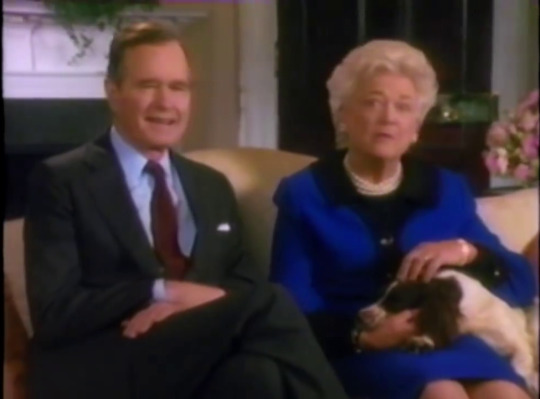
Funded by McDonalds, Cartoon All-Stars is an extension of the “Just Say No” campaign that was the brainchild of the Reagan administration. Those fingerprints are all over the home video release, which opens with a treacly and seemingly endless advertisement for Ronald McDonald Children’s Charities, followed by a message by then-current President George Bush and his wife Barbara that amounts to little beyond explaining the cartoon’s premise and re-iterating that drugs are indeed bad. (Subsequent TV broadcasts in Canada, Australia and New Zealand would replace this portion with a message from each nation’s respective big cheese.)


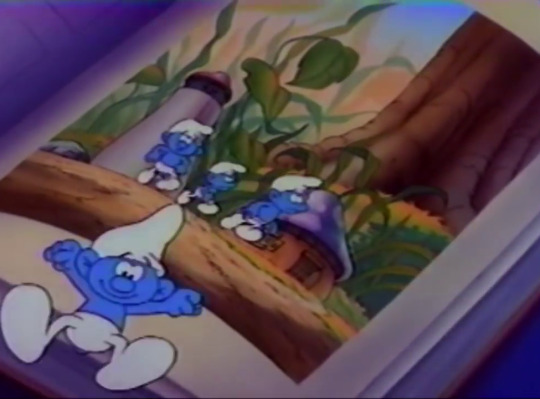

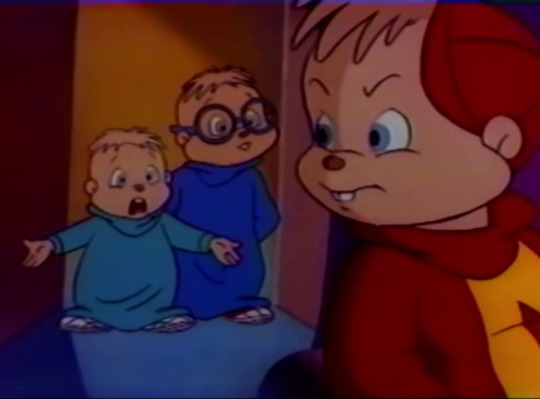
The show proper kicks off with the piggy bank of a little girl called Corey being stolen while she sleeps. Watching this from inside a comic book are The Smurfs, who march out into the real world to alert her. Also coming to life is the cartoon version of ALF, who springs forth from a picture frame. He in turn awakes a Garfield lamp, who for the purposes of the show is now the famous cartoon cat himself. When Garfield announces he’s too lazy to help out, ALF threatens to eat him. I’ve gotta say this pairing actually has pretty great chemistry. Alvin and the Chipmunks are also here and for the moment have nothing much to contribute.
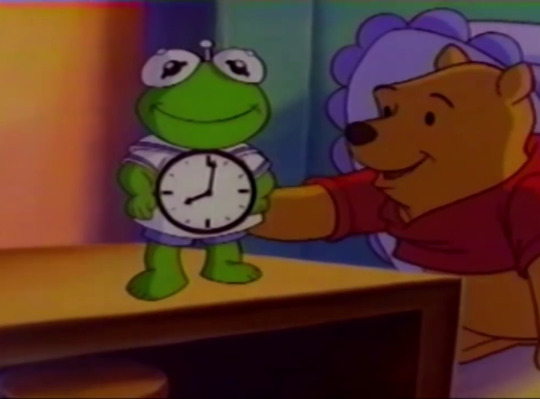



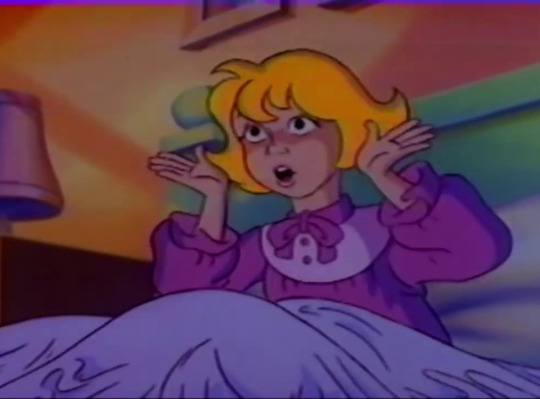
With the aid of Winnie the Pooh – formerly a stuffed toy – the various cartoon characters wake up an alarm clock of Kermit the Frog, seen here in his Muppet Babies incarnation, who in turn interrupts Corey’s slumber. Slimer from The Real Ghostbusters then passes through the wall into the bedroom, and as he wasn’t formerly a toy or some other household item, I guess he may be the actual Slimer. If you’re wondering why RGB wasn’t represented by at least one of the actual Ghostbusters, keep in mind that this was during the period where network executives had decided to push Slimer to the moon, to that show’s detriment. The green ghost swallows a desk lamp made to resemble some fruit, and subsequently shines a light on the spot where the piggy bank is now missing.



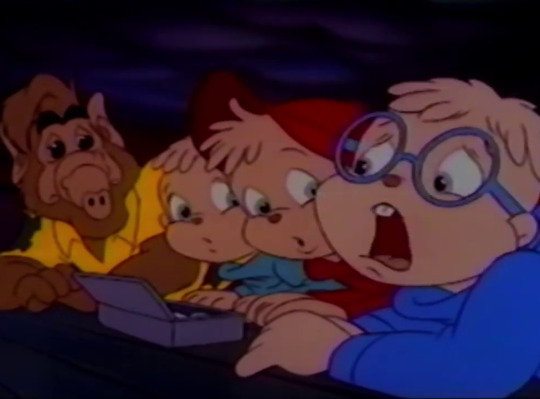
The toons sneak into the room of Corey’s brother Michael and watch him smash the piggy bank, scooping up the money inside; as Corey herself soon shows up to confront him without their help, they’re really only here to provide running commentary at this point. During the domestic squabble that follows between the two siblings, Michael hides his stash under the bed, unaware that the various cartoon characters are hiding there. This leads to one of the special’s funnier moments as Simon of the Chipmunks confirms Michael is in possession of “marijuana - an unlawful substance used to experience artificial highs!”

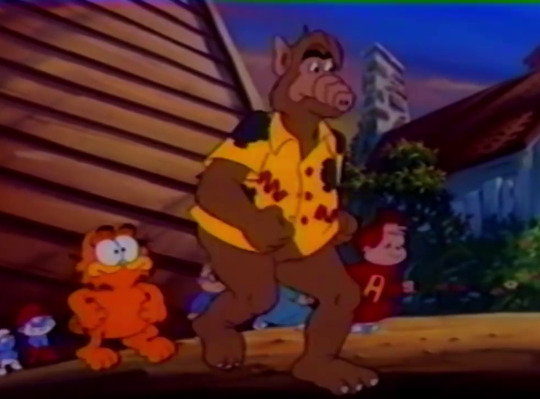

Michael storms out of the house, and the assembled cartoons head off to confront him. Winnie the Pooh stays behind to pursue his own sub-plot, but makes a point of wishing the others good luck.







At the arcade, Michael hangs around with a group of Cool Kids™ and is egged on by a ghostly cartoon pusher called Smoke to try harder drugs. The sound of approaching sirens leads the kids to split up, with Michael fleeing into an alley. He’s confronted by a police officer who turns out to actually be Bugs Bunny. After briefly containing Smoke in a trash can, Bugs lectures Michael about his behaviour, leading him into a time machine. Meanwhile Michael’s father notices some of his beers have gone missing, and Corey is pressured by Winnie the Pooh to confess everything she knows to her parents.


Bugs transports Michael to the past, where everything is in black and white and people prominently wear their initials on their clothes to aid in viewer identification. The rabbit shows Michael how he picked up his current habit and goes back and forth with Smoke debating the risks and benefits of his actions.

Michael’s father is busy in the shed with his... “KLIY”(?) when Corey appears to further her own B-plot. She tries to tell him about Michael, but it doesn’t go well. Okay, enough of this, let’s get to the reason why we’re all here.
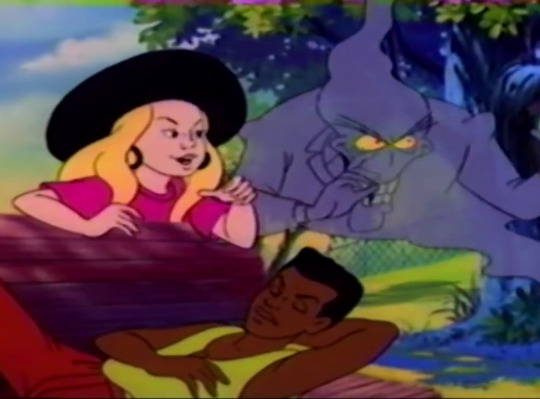





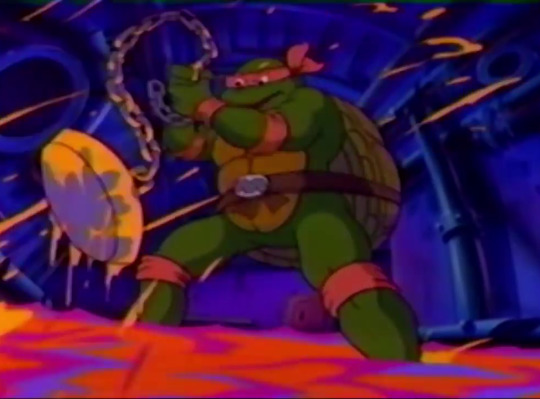
Michael has apparently been dumped back in the present day by Bugs, and is now hanging out with the Cool Kids again when they decide out of nowhere that maybe they could try crack. Smoke is also present to spur them on, and although Michael is hesitant, the others soon steal his wallet. While in pursuit, he falls into a sewer, where he’s confronted by Michaelangelo. As the animation for this special was handled by Wang Film Productions – who handled the visual oddity that was “Cowabunga Shredhead” - Mikey is bigger and puffier-looking than usual, looming over the other characters. He’s also angrier than we typically see him as he reads both Michael and Smoke the riot act. This segment ends all too quickly as Mikey yanks a giant plug-stopper out of the sewer waters beneath his feet, pulling the boy and his enabler into the drain below.

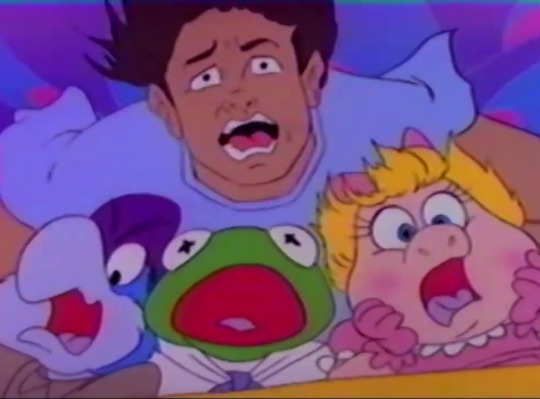

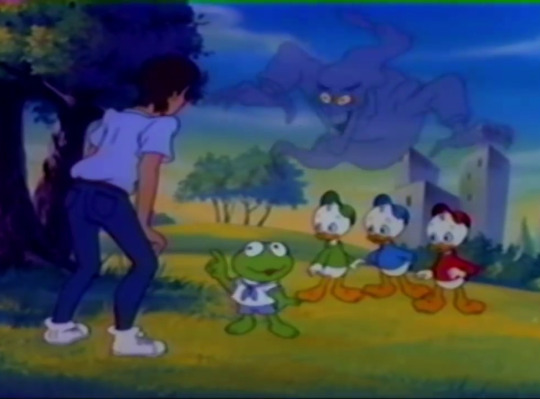

Michael and Smoke then find themselves on a roller-coaster ride with baby Kermit, Miss Piggy and Gonzo, who demonstrate the effects that drugs are having on Michael’s brain. After waking up in a park, Michael then encounters Huey, Dewey and Louie, who perform a song about the virtues of saying “no”. Some of the other characters who’ve appeared throughout the special also chip in to suggest excuses Michael could use to not take drugs; Michaelangelo eventually pops up to suggest “I’ve got too much homework”. (Mikey isn’t particularly well-drawn here, and has some funky-looking arms.)




Waking up in his bedroom, Michael is confronted by Corey, so I guess that last sequence may have been a dream, and the roller coaster scene was itself a dream within a dream. The two siblings bicker some more before ALF pulls Michael into a hall of mirrors, presenting a ghoulish reflection of the teenager which the alien insists is what he really looks like. All of this would be fine if it wasn’t for the fact that we as viewers can see that Michael does not in fact look like the Cryptkeeper, so the whole thing comes off as if ALF is gaslighting him.
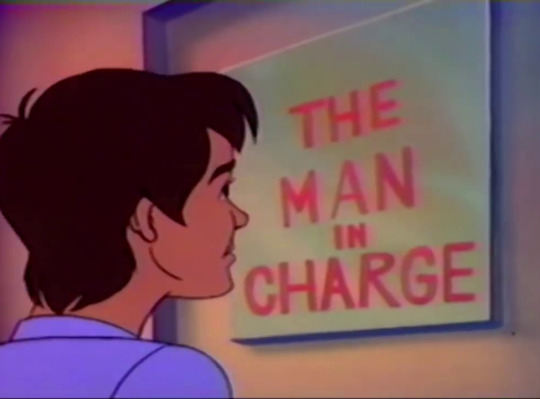
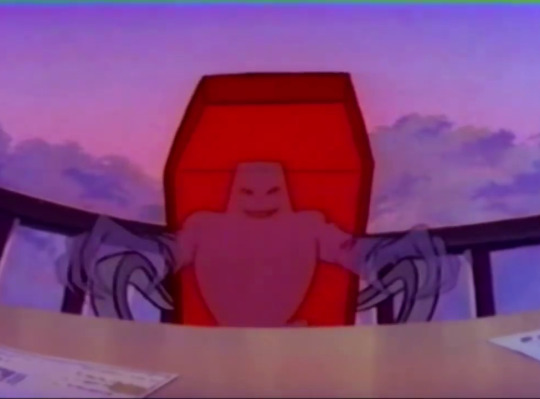

ALF then guides Michael to a room where a sign on the door reads “THE MAN IN CHARGE”. Inside is a crude, boxy approximation of Smoke, who then jump cuts to his normal character model. Wait, did the animators just draw some kind of fill-in figure and then accidentally leave it in the finished show? Roy Disney said at the time of this special’s release that the animation was done in eight weeks, which seems implausible, but there’s no doubt from looking at it that it was a rush job.
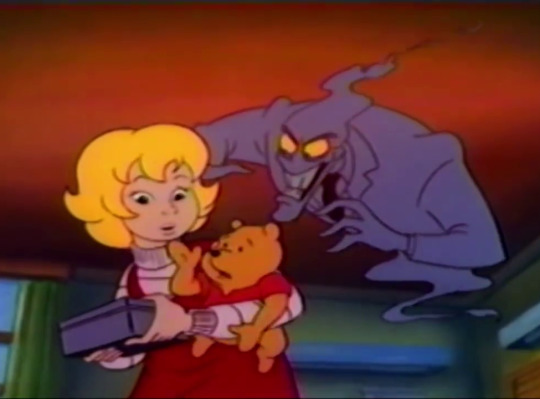








Corey enters Michael’s room and discovers his stash, which leads to her having an encounter with Smoke. Winnie the Pooh warns her that he’s bad news, only to get thrown into a nearby cupboard. Meanwhile Michael is having a bad trip, imagining that he’s being chased by Dewey on the Roller Coaster of Death, or something to that effect. He bounces through some more nightmarish scenes as discordant rock music warbles, before finally winding up outside a “SEE YOUR FUTURE” tent. Inside is Daffy Duck, who reveals the fate that awaits him, as a zombie-like Michael is seen writhing on a table.


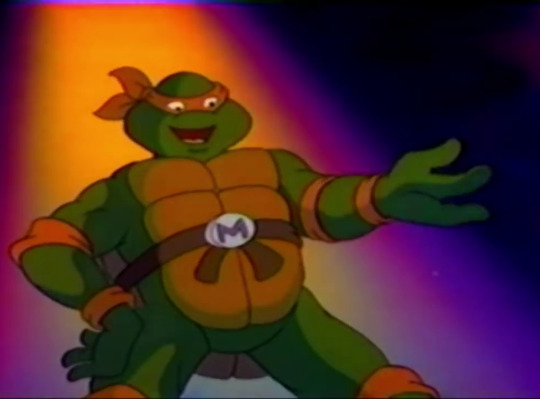
The “All-Stars” then assemble once more and everyone again gets to say their own little bit about the importance of not doing drugs. Michaelangelo materialises, looking somehow even worse than in his previous appearance, and chips in by telling Michael he’s excellent “just the way [he is] - without drugs!” I get what he’s going for here, but it’s a confusing statement as he clearly is currently very much “with drugs”.
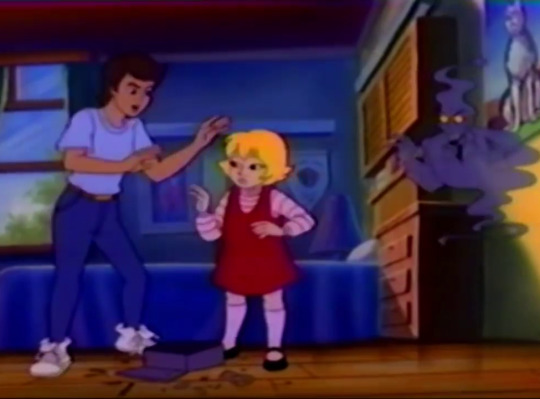
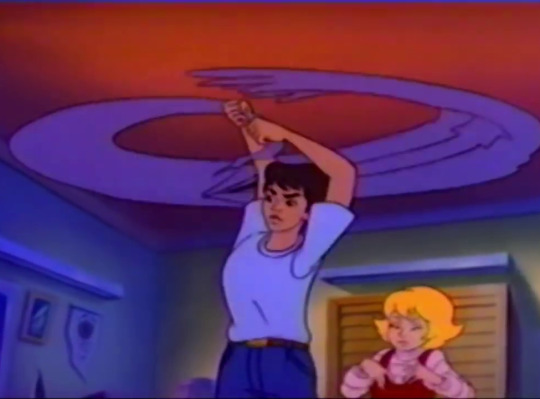

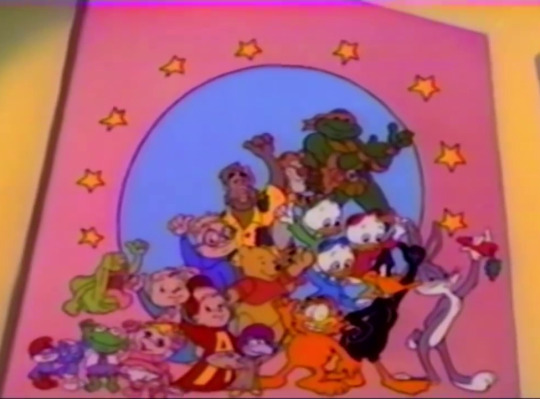
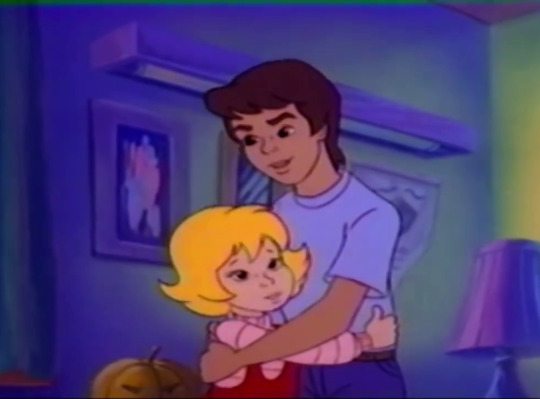
Having finally had his big revelatory moment, Michael returns home and confronts Smoke, who’s in the middle of trying to win over Corey. The teenager hurls the ghostly villain into a garbage truck passing outside, and the siblings vow to be ready should he return. They’re cheered on by the Cartoon All-Stars, who apparently now all reside on a poster even though that wasn’t where any of them started out. Michael and Corey decide to “go talk to mom and dad”, and the lengthy credits abruptly roll. Just in case you forgot who ponied up the dough for all of this, the Ronald McDonald House ad runs for a second time at the end of the VHS release.
Cartoon All-Stars to the Rescue has developed a reputation as something of a cult oddity over the last three decades and it’s not hard to see why. There’s an uncanny quality to the whole thing – the bizarre sight of The Chipmunks and the like talking in detail about drug use. The project is emblematic of the wider “Just Say No” and contemporaneous D.A.R.E. movements, as well as the wider War on Drugs ethos of the time, all of which hinged upon the idea of educating otherwise unwitting children about the subject early on in the hopes that this would turn them off, when it actually turned out to have the opposite effect.
Beyond the novelty of your kid-vid faves rappin’ about drugs, the other obvious reason this special still gets talked about is the crossover element. While having characters from otherwise unrelated properties interacting with each other is commonplace now – particularly given that the vast majority of all major IPs are now owned by five or six massive media conglomerates – this kind of thing was almost unheard of in 1990, Who Framed Roger Rabbit? being the obvious exception. What we get as a result is a line-up of notable fixtures of Saturday morning network line-ups in this era, as well as some old-timers like Bugs and Daffy. It’s revealing, however, that Disney weren’t about to offer up their counterparts here, and that neither Mickey nor Donald – or even Goofy, for that matter – were up for use.
Further analysis of the line-up also demonstrates how much the pendulum had swung back by 1990, in that only Michaelangelo and Slimer represent action-adventure cartoons. If this project had been commissioned five years earlier, it’s easy to imagine the cast being dominated by the syndicated stars of the day, with He-Man, She-Ra, Bumblebee, Lion-O and members of GI Joe all making an unlikely alliance to scold Michael for his weed use. As it is, Cartoon All-Stars marks the first cross-over event between the Teenage Mutant Ninja Turtles and the Ghostbusters, something we wouldn’t see again until IDW published a four-issue comic mini-series bringing the two teams together in 2014. Michaelangelo and Slimer have no real interactions with each other in this special, in fact poor Slimer is barely used at all. (The Turtles are on the rise at this point though and it’s arguably been at the expense of the now-waning Ghostbusters, a subject we’ll revisit another time.)
As an aside, I should point out that I’m not aware of any TV screening or VHS release of Cartoon All-Stars to the Rescue in the UK. It’s hard to imagine the three major broadcasters at the time working together to simulcast something like this in the spring of 1990. The BBC in particular had gotten into hot water three years earlier for an anti-drugs storyline in Grange Hill that revolved around a character becoming addicted to heroin, and surely wouldn’t have wanted to go down that road again; as we’ve covered previously in Turtlethon, they also had an ingrained cultural resistance to US cartoon characters in general. The involvement of McDonalds in the creation of this whole affair couldn’t have helped either.
Cartoon All-Stars to the Rescue is must-see viewing for any afficionados of eighties or early nineties TV animation, if only to experience how figuratively and literally trippy the whole misguided project is. Due to the spider-web of rights issues involved and the fact that this was a not-for-profit venture anyway it’s widely available online, and in fact a nice 720p VHS rip is now up on the Internet Archive for you to enjoy. On our journey through the history of the original Teenage Mutant Ninja Turtles show it marks an interesting turning point, where the green teens are the biggest stars in all of animation, and not yet Saturday morning mainstays like the other characters here, though that would soon change.
#Cartoon All-Stars to the Rescue#1990#PSA#PSAs#Teenage Mutant Ninja Turtles#TMNT 1987#tmnt mikey#tmnt michelangelo#tmnt michaelangelo#ALF#Garfield#Slimer#Muppet Babies#TMNT#Ninja Turtles#Just Say No
2 notes
·
View notes
Text

he has a framed picture of ronald reagan fsjhfjhdfsj what else could you expect from an nsa agent i guess
2 notes
·
View notes
Text
Oscar Isaac and Robert De Niro in the same film! 🤯
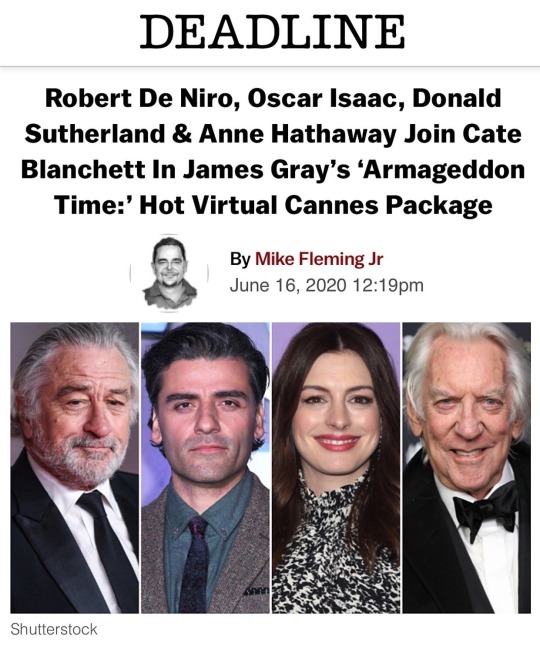
EXCLUSIVE: Robert De Niro, Oscar Isaac, Donald Sutherland, and Anne Hathaway are set to join previously announced Cate Blanchett in Armageddon Time, the period drama that James Gray will next direct for RT Features.
Wild Bunch International will introduce the film to buyers at the virtual Cannes market and represent the film’s international rights. CAA Media Finance, which arranged financing, represents the film’s domestic distribution rights. WBI and CAA Media Finance are co-representing the Chinese rights.
Gray wrote and will direct, and re-teams with RT Features following their recent collaboration on Ad Astra, the Brad Pitt space thriller that co-starred Sutherland. RT Features’ Rodrigo Teixeira will produce, with Lourenço Sant’Anna and Rodrigo Gutierrez executive producing.

Gray crafted a drama based on his childhood memories, a big-hearted coming-of-age story that explores friendship and loyalty against the backdrop of an America poised to elect Ronald Reagan as president. It is very different from his recent pictures, and he hopes to shoot in New York as soon as post-pandemic opportunities make it possible. He spoke to Deadline about his ambition.
“Every film you make is different, but I’m trying to do something that is the opposite of the vast, lonely and dark void of the movie I just directed,” Gray said. “I’m anxious to make something that is very much about people, about human emotions and interactions between people, and I want it to be filled with warmth and tenderness. In some sense, yes it’s about my childhood, but an illustration of familial love really on every level. I’m of the belief that most people do their best and that they try their best under difficult circumstances and in some sense that’s a beautiful thing and very moving to me.
“In a grander sense if I may sound a little sententious and pretentious, history and myth always begin in the microcosm of the personal and though you are using something so small and specific in your life, the result can become universal if it accesses real emotion. I’ve tried to move to the opposite of a cold dark space. I want to be political and historic about it, but fill it with love and warmth. What happened with me, very simply, I got in big trouble when I was around 11, though the boys are 12 in the movie, and the story is about my movement from the public education that I got into private school and a world of privilege. This film is about what that meant for me and how lucky I was, and how unlucky my friend was and about that break meant for me and what it meant for him.”
Previous stories mentioned that the private school was one attended by future U.S. President Donald Trump.
“The private school, yes Donald Trump went there and Fred Trump was on the board of trustees,” Gray said. “It’s symbolic about what the school represented at the time, entrenched in this white protestant ethic. I found it very foreign to me, a product of the public school system in New York City of the ‘70s. It’s about that transition and how it reflects on what the American society was and sadly still is. How we are separated along the lines of class and ethnicity. The film is really about that, my transition in school from one to the other. The implications of it are quite large. The world really became clearly divided to me, based on the haves and the have-nots. I didn’t write the script last week, but rather many months ago and it’s weird in that a lot of what we’re seeing right now is playing out of many of the themes that it was my ambition to explore in the first place. This obsession I have with examining American ideas of class mobility, to do it in a context that is humane with social impact.”
Gray is bullish that when moviegoing returns, people will want to be moved, and he believes Armageddon Time will fit that bill.
“Films do intimacy and family relationships very well, even better than the theater, because in the theater your best seat is still 20 feet away from the actor,” Gray said. “In the cinema, the close-up has tremendous power. What I’m after is something really quite moving. My recollection when I think back on that moment, which is 1980 as the time frame of the movie, and what an important year it was in the history of the country and for me personally and how in some ways, I was pretty damn lucky. My parents who were not wealthy at all as a working class family, used all the levers they could, to be able to go to this school. Which simultaneously saved my life, but also awakened me to real racism and anti Semitism. In some ways, the idea of presenting a story like this within the context of this family, told with great warmth, is sometimes your greatest Trojan Horse, to involve people emotionally that way. And story is a great weapon to be able to deliver some pretty harsh news.”
De Niro, Sutherland, Hathaway, Blanchett, Gray, and RT Features are represented by CAA. Hathaway is also represented by Management 360. Isaac is represented by WME and Inspire Entertainment.
###
#oscar isaac#armageddon time#james gray#robert de niro#donald sutherland#anne hathaway#cate blanchett#rt features
64 notes
·
View notes
Text
Historical environmental portraits. Inspiration.
Arnold Newman (03.03.1918 - 06.06.2006) was a n american photographer known from environmental photography.
Newman began his career as a photographer by working in network portrait studios in Philadelphia, there he acquired his first photographic skills. In the meantime, he also tried out documentary and abstract photography. He has worked for Fortune, LIFE, Newsweek and Harper's Bazaar, photographing artists in particular.
Arnold Newman photographed famous people like - Marlene Dietrich , John F. Kennedy , Harry S. Truman , Piet Mondrian , Pablo Picasso , Marilyn Monroe , Ronald Reagan , Mickey Mantle and Audrey Hepburn.
Newman was one of the world’s best known portrait photographer. In his environmental portraits, he focuses on the surroundings in which a person is photographed to show his profession or personality e.g. writer - at the desk, pianist - next to the instrument. Despite the fact that Newman set up his models for photos, the photographed themselves felt at ease because they were in their own environment.
“You don't take pictures with your camera. You take pictures with your mind and your heart.”
-Arnold Newman

Grandma Moses (1949)
I like this image because it looks very peaceful and nostalgic. It reminds me of one of my auntie who had similar room in her house where she was inviting guests. I was a little girl when I saw her last time, I remember a lot of flowers and windows in this room.
When I look at this image it brings back nice memories.
This image was lit with natural window light. Light is falling on Grandma face and hands. I like the contrast between light and shadows.
This photo was taken by photographer from a short distance, from the eye level perspective. Thanks to which we can see the environment in which this person is.
I think the photo was taken in a room where this person like to be, look out the window, watch nature or wait for her grandchildren. Thanks to the right choice of place, this person looks natural and comfortable.

Robert Doisneau, photographer, New York, 1981
I like this image because of the simplicity and humor. This photo is focusing more on the place than on the subject matter. You can clearly see that the photo is posed as it is rare for an older person to peek over the edge of a wall or other object. I’m assuming that the image is lit by natural window light situated somewhere on the right, I can say that because of the soft shadows and contrast between left and right side.
This photograph was taken from a little distance from subject matter, from eye level perspective. I think if the perspective would change the photo could tell different story. The environment showed on this image represents this person
I see this image as working place of this person which is photography - chair in the middle of frame and simple white background, person peeking can symbolize that as a photographer he’s always behind the scene, never in center.
https://www.theboulevardiers.com/2014/11/25/arnold-newman-master-class-in-portraiture/
https://imageexplorers.com/photograph-like-arnold-newman/
https://huxleyparlour.com/works/grandma-moses-eagle-bridge-ny-1-october-1949/
1 note
·
View note
Text
Tribute to Eleanor Parker by Roger Fristoe

When I was a youngster watching the 1952 film ABOVE AND BEYOND, I knew nothing about the movie’s leading lady, Eleanor Parker. But something about her instantly captivated me. It was partly that elegant face with the classic profile, the sweep of her brow and a framing wave of blonde hair. Her low-pitched, resonant voice also carried a charge.
Above all, I loved Parker’s acting. Although too young at the time to understand the fine points of her performance in ABOVE AND BEYOND, I realized at some level that it was both completely natural yet somehow heightened. She found variety and passion in what might have been a one-note character, the loyal wife of a pilot facing the most formidable mission in Air Force history – dropping the A-bomb on Hiroshima.
The next Parker movie I saw was another 1952 release, SCARAMOUCHE. Her theatricality was given free rein in this one, and her sparkling performance was so opposite the one in ABOVE AND BEYOND that I could have sworn I was watching a different actress. Now a ravishing redhead in lavish costumes and elaborate stage makeup, she is the commedia dell'arte spitfire who spars with the title character played by Stewart Granger.

I was hooked. As I followed Parker’s film career over the years, catching each new movie in the theaters and reviewing her earlier work on television, I continued to be astounded by her versatility and somewhat puzzled that she wasn't an even bigger star.
She had it all – beauty, glamour, talent and an intense drive to break new ground as an actress. She attracted many of the movies' most prominent leading men, including: Errol Flynn (twice), John Garfield, Ronald Reagan, Humphrey Bogart, Fred MacMurray, Kirk Douglas, Stewart Granger, Robert Taylor (three times), William Holden, Glenn Ford, Frank Sinatra (twice), Robert Mitchum and Clark Gable. She was even billed above Charlton Heston on his home turf at Paramount Pictures during his heyday in the mid-1950s.
Parker refused to be typecast and project the same image in film after film. Also, she was reluctant to promote herself in the manner of most Hollywood stars. She disdained interviews and other publicity and was so shy of attention that she hated the idea of winning awards because she'd have to make an acceptance speech.
So this was an actress who never quite had the audience recognition bestowed upon such contemporaries as Susan Hayward and Lana Turner. I remember once remarking on what a favorite of mine Eleanor Parker was, only to be met with the response, "Oh, yeah, isn't she that tap dancer who was married to Glenn Ford?"

TCM's 2019 birthday tribute to Parker (who would have been 97 on June 26), doesn't cover her three Oscar-nominated performances: as the innocent-turned-hardened-convict in CAGED (1950); the tormented wife in DETECTIVE STORY (1951); and Marjorie Lawrence, the opera singer felled by polio, in INTERRUPTED MELODY (1955). Also missing are some of her most entertaining adventure/romances; in addition to SCARAMOUCHE there are ESCAPE FROM FORT BRAVO (1953), THE NAKED JUNGLE (1954) and MANY RIVERS TO CROSS (1955).
However, the tribute does cover the arc of Parker's career from contract player at Warner Bros. through her years as an independent actress and a star at glamorous MGM. THE LAST RIDE (1944) was the final in a series of B films she made for Warner Bros. In NEVER SAY GOODBYE (1946), her first movie with Errol Flynn, she looks gorgeous and shows a knack for comedy that would blossom in later films.
Also in 1946, Parker and Warner Bros. took a chance with her appearance in a remake of W. Somerset Maugham's OF HUMAN BONDAGE, playing the role in which Bette Davis had created a sensation 12 years earlier. Deemed lacking at the time of the remake's release, Parker's performance has since grown in stature. Despite problems in the film itself, I consider Parker's portrayal as good as Davis's and in some ways superior. (Parker's Cockney accent was so convincing that some English cast members thought it was for real.)
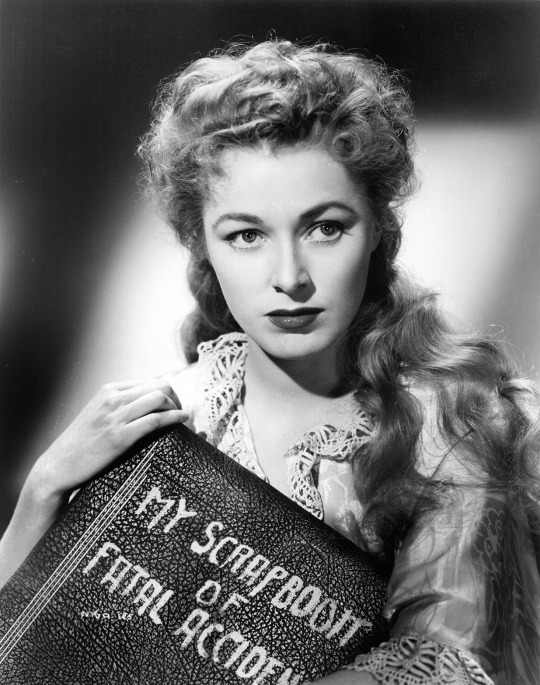
THE MAN WITH THE GOLDEN ARM (1955), directed by Otto Preminger and released through United Artists, has Frank Sinatra as a jazz drummer hooked on heroin, with Parker coming on strong as his possessive/obsessive wife.
Parker's MGM period is represented in the tribute by three films. In LIZZIE (1957), she delivers a performance as a woman suffering from a multiple-personality disorder that is every bit as expressive as Joanne Woodward's Oscar-winning turn the same year in THE THREE FACES OF EVE.
THE SEVENTH SIN (1957) is another Somerset Maugham story and another redo of a formidable performance from 1934 (Garbo's in THE PAINTED VEIL, the original title). It gives Parker a nice dramatic workout and proves that, like Garbo's, her face was a cameraman's dream.
In HOME FROM THE HILL (1960), a family melodrama set in Texas and directed with enjoyable flamboyance by Vincente Minnelli, Parker holds her own with Robert Mitchum as his embittered wife.

By the mid-1960s Parker was working mostly in television, where she found a wide range of parts, with an occasional featured role in films. She had her final role in 1991 and died on December 9, 2013.
Ironically, the best-remembered role of Parker's career is probably THE SOUND OF MUSIC (1965), in which she has a supporting role as the lovely, cool, chic, witty and lightly sardonic Baroness who loses Christopher Plummer to wholesome, perky Julie Andrews. (It was a decision on his part that I could never quite understand.)
I shared Plummer's real-life feelings about Parker when, on the occasion of her death, he offered this lovely quote: "I was sure she was enchanted and would live forever."
157 notes
·
View notes
Text
Natural Born Opponents
Oliver Stone's Natural Born Killers has been linked to more violence than any other movie. But when John Grisham learned that a friend of his had become the latest victim of one such copycat killing, the best-selling novelist and lawyer decided to hold Stone accountable. [...]
Hollywood's dark tradition of inspiring reckless and criminal behavior includes one presidential-assassination attempt (John Hinckley's shooting of Ronald Reagan, linked to Taxi Driver), outbreaks of gang violence and/or murder (Colors, New Jack City, Menace II Society), and the murder and mutilation of a prostitute (The Silence of the Lambs). Two years after its theatrical release, though, Natural Born Killers remains in a class by itself, having been linked to more copycat killings than any film ever made. To its creator, the incidents merely confirm the film's vision of America as a society that glamorizes violence. But critics of Natural Born Killers observe that in the film, unlike in real life, violence occurs in a moral void. Mickey and Mallory, the hallucinogenic-drug-ingesting thrill riders portrayed by Woody Harrelson and Juliette Lewis, are not, in the end, forced to reckon with justice as, say, Bonnie and Clyde are. They grow world-famous as their murder toll climbs. Arrested by corrupt and pathological cops, they break out of prison like heroes and ride away happy as the closing credits crawl.
Indeed, the closest precedent for Natural Born Killers, in the gleefulness of its characters as they conduct violent acts, and the relative freedom they enjoy in the end, is A Clockwork Orange. Upon its release in 1971, critics wrote admiringly of its violence as a social statement. [...]
"What do I want from Stone?" Simpson says in his office near the Amite courtroom. "If he's found negligent, you're looking at $20 to $30 million."" [...]
The question I have as I re-emerge from the Byerses's trailer—appreciating for a moment the simple pleasure of walking—is this: Would Ben and Sarah have done what they're accused of doing without the influence of Natural Bom Killers?
Oliver Stone, of course, has his own answers. In a response to Grisham published in L.A. Weekly, the director declares that his accuser "is on the age-old hunt for witches to explain society's ills . . . ignoring Shakespeare, who reminds us that artists do not invent nature but merely hold it up to a mirror." Follow Grisham's logic, he suggests, and look where it leads. "Has your father been brutalized? Sue Oedipus and call Hamlet as a witness. Do you hate your mother? Blame Medea and Joan Crawford. Has your lawyer-husband been unfaithful? Slap a summons on Grisham since, after all, he wrote The Firm."
Grisham, observes Stone, says that both Sarah and Ben had had serious drug problems and received psychiatric treatment. If they watched Natural Bom Killers "at the crucial moment when the carefully twisted springs of their psyches finally uncoiled," the film is hardly to blame for that. Parents and schools are more accountable; so is television, with images of violence far more pervasive than those of one two-hour film. Even so, Stone writes, "an elementary principle of our civilization is that people are responsible for their own actions."
Two of the country's best-known First Amendment lawyers agree with Stone, and find Grisham's legal reasoning dubious at best. "I'm kind of surprised by Grisham," muses Martin Garbus, who has represented Andrei Sakharov and Peter Matthiessen. "We all believe words have some meaning . . . but product liability? That's silly. The whole point of product liability is that you have to show a causal effect. With breast implants—or with cigarettes . . . we've seen over the years how hard it is to prove causal effect. When you get into the area of what triggers a person's mind, you get into the realm of fairy tales. . . . When I was a kid, I was terrified by Fantasia and by Bambi, when the mother deer was killed. Those moments are etched in my mind. But I didn't go out and murder anyone because of it."
Even if such an effect could be shown, says Floyd Abrams, who has represented The New York Times since the Pentagon Papers, "the notion that because one crazed person reacts to a book or movie by doing something illegal the moviemaker or writer should be liable is at war with the First Amendment." So, says Abrams, is Grisham's whole notion of a film as a product. "[Grisham's] books, modest from a literary perspective, are not like breast implants. They are fully protected First Amendment speech, and the notion of judging them from some almost undefinable negligence standards is very troubling."
Oliver Stone, presented with Grisham's indictment, responds in turn from Los Angeles. "If Grisham were the author of delightful bedtime stories, I could perhaps understand his perspective on my work. However, given the fact that his work is all built around the committing of heinous crimes (murder, the rape of a young child, suicide), his attacks on me seem more than disingenuous. The fact is, Mr. Grisham has become a very rich man off a body of work which utilizes violent crime as a foundation for mass entertainment.
"For example, his book (soon to be a major motion picture) A Time to Kill has as its protagonist a man who murders with clear premeditation two young racists who raped his 10-year-old daughter (a rape which Mr. Grisham writes about in horrifyingly graphic detail). The man's lawyer wins his freedom for these murders of vengeance. Mr. Grisham invites his readers to cheer the man's release, although he is unequivocally guilty of murder.
"Thus, one may presume that, according to Mr. Grisham's logic, the next time a 'righteous' revenge murder takes place (or, for that matter, the rape of a child) he will be happy to assume liability if it can be shown that the offender had read or seen A Time to Kill."
Point to Mr. Stone, though it seems, to this moderator, that Grisham presents his violence within a moral order. His protagonist in A Time to Kill is found not guilty by reason of insanity, but only after a lengthy trial that shows all the checks and balances of the law at work. Natural Born Killers has no moral frame.
Stone, of course, disagrees.
"Natural Born Killers is an in-your-face satire of a moral order turned upside down," he declares. "It's a wake-up call to a schizophrenic country and culture which decries violence but just can't get enough of it. Viewers are bombarded day in and day out by tabloid trash shows, entertainment and news programs which convert tragedy into soap opera, replete with weepy musical sound tracks and reportage that drips with fake emotion. ... So much for the 'moral order' that Natural Bom Killers is accused of upsetting."
Stone's response is persuasive, and set against it, Grisham's argument pales. Establishing cause and effect between screen violence and real-life violence seems all but impossible to do in any clear, definable way; even if it were possible, allowing courts to draw lines between acceptable and unacceptable art would not only subvert the First Amendment but be a fine prescription for Fascism.
-Michael Schnayerson, "Natural Born Opponents," Vanity Fair, July 1996 [not available online]
8 notes
·
View notes
Photo
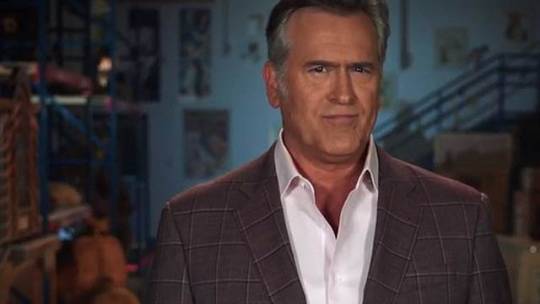
Bruce Campbell exclusive on reboot of Ripley’s Believe It or Not! for Travel Channel.
Fan favorite actor Bruce Campbell is executive producer and host of the reboot of Travel Channel’s new series Ripley’s Believe It or Not!
Filmed inside Ripley’s warehouse, each segment is a thorough concise look at unique individuals who blow people’s minds with their gifts. It runs the gamut from physical exceptionalism to flat-out death-defying deeds. Steering this eye-candy-licious ship is Campbell.
Over the film and television career of actor Bruce Campbell, we have loved his take on horror roles (Ash Williams in The Evil Dead franchise), perfectly honed dramatic characters (President Ronald Reagan on Fargo), and most recently as the critically acclaimed developer Gary Green in a three-episode arc on AMC’s Lodge 49.
Of course, Burn Notice fans loved him as Sam Axe, and legions of Starz’ Ash vs. Evil Dead fans are bereft over Ash’s recent cancellation and demise there.
This latest venture for Campbell sees him entering the production side of TV as well, and his instincts are dead-on accurate for what reality TV watchers want, well crafted true stories with no wasted frames, lots of heart, and plenty of jaw-dropping reveals.
We screened the premiere episode and were completely riveted to the tales.
Ohio native Rick Smith flicks playing cards at lethal speeds while dreadlocked Dai Andrews can swallow curved swords and live to talk about it. Tyler Scheuer takes it on the chin — literally — as he balances heavy odd objects.
Toronto native “Twisty” Troy James is a handsome contortionist who has worked in many TV shows (FX The Strain, CW’s The Flash) and movie roles, with his mentor Roberto Campanella referring to him as a “natural talent” and a “walking talking natural effect.”
The 10-episode, hour-long series is inspired by Robert Ripley’s love of the extraordinary in humanity, and Campbell is a good steward of this. We spoke to Campbell by phone yesterday for a fascinating interview:
Monsters & Critics: I’m incredibly jealous of you.
Bruce Campbell: Why is that?
M&C: Well, the Ripley’s Warehouse. You got to work in it… and poke around.
Bruce Campbell: Oh yes… I’ll never tell. I’ll never tell the secrets that I saw.
M&C: But what was the standout item that was a jaw-dropper for you?
Bruce Campbell: Well they always rotate displays. They had a [President Donald] Trump in the foyer. They had a life-size Trump. So I got a thumbs-up picture with that. So I’ve had a picture taken with a president.
They also had a life-size replica of the tallest guy ever. And when they do that, that’s different than a photograph. And they have all these great craftsmen that work in the warehouse doing prosthetics and doing these life-size replicas of things. And when you see that life-size of the tallest man ever, you go, “How does anyone get that big?” It really puts it in perspective.
So stuff like that was cool. I’m a sucker for enormous, oversized objects.
M&C: I think I saw that in the background on the premiere episode…
Bruce Campbell: Oh yeah, it’s hard to hide that guy.
M&C: I love that you’re serving as host, but you’re also wearing the executive producer hat. I’m sure someone like yourself, with a bazillion fans from every level, gets pitched a million things. Who contacted you? I know that you were aware of Ripley’s and you liked it as a kid…
Bruce Campbell: Oh, of course. Things come across your desk. They tracked down my agent, and then he throws it at you and you either ignore it or say yes, or no, or maybe.
And Ripley’s, soon as they said that, I’m like, “Okay, I’ve heard of that.” And, “Who’s it for?” “Travel Channel.” “Okay, I’ve heard of that.” So they were two for two, and that’s helpful.
I knew Ripley’s and I was fascinated by a lot of that stuff anyway. I felt it’s a pretty good fit for the Evil Dead crowd because we’re basically talking about people who live on the edge … these people who push it.
So it’s pretty good. It felt right. And the Travel Channel … it’s not your father’s Travel Channel anymore. So it’s a good fit for Travel Channel because they’re doing all these crazy, creep investigations now and stuff. I think it fits it right in.
M&C: Dovetailing on what you said earlier, I think we’re all fascinated with the human body. So much good, bad and otherworldly can happen in the human form; and afflictions, to gifts, talents.
Bruce Campbell: To DNA glitches.
M&C: Yes, exactly. And I think that that’s an interesting thing that the show… we don’t have “the freak show” anymore… but Ripley’s show, you’re kind of bringing back a Victorian freak show but in a much more humane and cerebral context...
Bruce Campbell: Well we don’t use the F-word anymore. We don’t, not in our Ripley world. Because you’ve got your ordinary people, and that’s you and me and our neighbor.
These people really are the extraordinary, beyond ordinary. What we’re doing is, we’re celebrating it. And my job as a producer… My input was tone.
So that you’re celebrating people who’ve overcome challenges; they are achieving great achievements just through tenacity and practice and focus. And a lot of life lessons in here. So the takeaway is very positive.
If it’s different from any other incarnation, it would be that — that people are not on parade.
Now granted, [there’s] no shortage of eye candy. There’s going to be a lot that’s going to make your eyes pop out. But in context, we want you to get to know these people, to understand, and in some cases respect their decisions.
M&C: Right. Each segment was really well-rounded for the time beat that it was, and you gave really good backstory. And it showed how people were prospering and making great livings, and absolutely celebrating their uniqueness. I like that you do that.
Bruce Campbell: It’s an incredibly dense hour. It’s a small hour. It’s like six or seven stories per hour. It’s crazy.
M&C: Yes. The first episode, Rick Smith with the flying lethal playing cards…The fact that he could lethally dismember someone’s finger…
Bruce Campbell: Yeah. He’ll kill you! At a press conference, he could kill you. He could kill you at a press conference. By the way, we’re going to try to drag some of these folks to conventions.
Because I told them, I said, “Look, this is what I do. You’ve got to…” How many boring movie panels have you witnessed, you know? Oh, it was very hot that day. Yes, my suit didn’t fit right. And we thought that was funny. “No, let’s get a panel of Ripley’s participants. I’ll give you a panel.” So we’re going to San Diego Comic-Con. We have a panel coming on, that Saturday.
M&C: You know it’s going to be standing-room-only. People are going to be hanging from the rafters…
Bruce Campbell: Well, it’s the right fit for that crowd too. And look, this is not Marvel. This is real, folks. These are real superheroes, for the most part.
M&C: When you look at your career, characters like Ash Williams, and Sam Axe… and then you’ve done very serious stuff in Fargo, and you had a great part in Lodge 49, which is a fun series. What kind of roles do you enjoy the most?
Bruce Campbell: Just mix it up. I think the fun is mixing it up. Because from Detroit, my hometown, as a factory worker you would hope that they had a thing called “job rotation.”
You’re putting tires on one week; next week, they move you to fenders; next week, you’re putting windows in. So you don’t go crazy. Because there’s a lot of rinse-repeat, in what we do. Television is done in a formulaic style, for the most part, at a certain speed, certain pace. And you have to kind of fold in, and get used to that.
But over the years, it’s been fun to also to exploit opportunities when they come up. Take something that is a little more out of the box. I’m doing Peter and the Wolf in front of my local orchestra, at the Britt Festival, here in Jacksonville, Oregon, this summer. And I’m all giddy about it.
I’m like, “Okay, yeah. Let’s do something with an orchestra.” So I’m going to narrate Peter and the Wolf. It is fun to actually live where you live. To participate. Because you can go hide, that’s pretty easy. But nice thing is, where I live, my neighbors… they could so give a crap about who I am or what I’ve done.
A neighbor… the week I moved in, he was a rancher across the street… he comes up the driveway. He goes, “I understand you’re a cowboy in a TV show.” I said, “Yes sir, I was.” He goes, “You know how to ride?” I said, “I think so.” He goes, “You want to help me run a hundred head of cattle up the road on Saturday?” I’m like, “Yeah, if you’ve got a horse.” “Yeah, I’ve got a horse.” I’m like, “Okay.”
So I met him on a Saturday. Met all the neighbors. We helped him run a hundred head of cattle up the road. And, there you go. I was a member of the neighborhood.
What’s nice is, you can actually just get out. As an actor, you actually don’t have to hide. Some actors spend way too much time hiding. I hide in plain sight. I’m behind you at the post office. I’m the guy with the cat hair all over his jacket.
M&C: Switching gears. So obviously I’ve trolled your Twitter feed. I’m looking for MK11 clues like everyone else…
Bruce Campbell: Oh, it’s gotten out of hand. It’s gotten completely out of hand. Here’s the absolute truth of it all: I’m a bad liar. So, here’s the truth of it.
There is an Evil Dead game that’s coming out. And it’s a fully immersive game. It’s going to be very intense. And we hope to be absolutely mind-blowing, like some new game.
But in the meantime what happens is, Evil Dead’s been reintroduced. Ash vs Evil Dead sort of made it relevant again. And there’s a lot of requests just to have Ash pop up, like a guest star, in a movie, or on a TV show. Have him pop up and do some crap.
So Dead by Daylight was pretty much that. Pop up, do a thing. But people thought that (a) I was a liar that, “Oh, I thought you were retiring Ash.” And then (b) that, “Oh, I guess Ash is now in this game,” like he was a fully immersed player.
And we started to see the ads for it like that. We were like, “Ahh, don’t misconstrue this.” I’m just popping in literally, saying like a dozen lines. Like, “Hey, come on baby,” or whatever. And he may pop up in other games.
M&C: Yes. Well, Mortal Kombat 11 (MK11). That’s where all the chatter is landing.
Bruce Campbell: It is.
M&C: And?
Bruce Campbell: Sure. Well, I would have to say that I can’t say anything officially. They have alluded to it because there’s a little chainsaw revving at the end when they allude to new characters. So there’s nothing I can say, but I can say that Ash has popped up in other games. And if he does pop up in this one, it’ll be in the same fashion.
It would be like a blink-don’t-miss it or load him for a quick little run at this, you know?
We’re saving full Ash. Full Ash is coming. We hope that this is just a warm-up, honestly. We’re actually doing it because… We’re saying it’s okay to do because it’s just sort of whetting people’s appetite for playing a game as Ash, which can be fun.
He’s a big trash talker. And he’s one of the few flawed heroes. He’s like you. He’s like your neighbor being a hero. It’s like you being a hero, just you putting a chainsaw on your arm. That’s what I think is cool.
M&C: It’s like giving a monkey a razor blade. Not a good idea.
Bruce Campbell: (laughs) Totally! Exactly. That’s dangerous. Give him a switchblade. That’s a better image. Like he pops it out, “Let’s go. Let’s rumble.”
M&C: Right. Your fans are something. Do the men meltdown easier than the women when they meet you in person? When I read interviews by fanboys who can’t hide it, it’s kind of cringey.
Bruce Campbell: It was mostly fanboys. My wife was always, “You have fun on your tours, with your fanboys.” Because she knew there was going to be no hotel-room keys being thrown my way because the demographics were like 90% guys.
And I’ve watched it go to 75-25. And now it’s basically 50-50, as far as fandom. And I’m saying that across the board, not just for me per se. Fandom is out of the closet. Geeks are out of the closest. The industry is currently run by geeks. It’s all good. It’s just, everything’s out of the closet now.
Our proof of our love of entertainment is out of the closet now. There’s more conventions than there ever have been, by 10 times. And the amount of TV that we actually binge is 10 times than we thought we were binging. It’s amazing.
M&C: To me, Ripley’s is almost like a history lesson, but time-traveling into the modern day…new stories…
Bruce Campbell: Well it’s seeing humans… What can the human body do? Question mark. What can it do? And this show answers some of those questions, in an amazing way. Blind kid just wants to ride his bicycle, just like another kid. Right?
He learns to echo-locate like a bat. Because bats fly around and go “click click,” little clicks, and it bounces off of the objects that they’re flying around. They can know how far away it is. Kid saw a bat do that. He was like, “Wait a second. I’m going to do that.”
So he starts clicking and bouncing sound off of buildings, and even trees. He knows how close they are, alleyways. And dog on it if he doesn’t learn how to ride a bike. And he gets so good at it, he’s teaching other blind kids how to do it so they can just ride a frickin’ bike. What a great story, what a great story.
Everything has to be a car accident, you know? These are really… I’d say 92% of our stories are uplifting.
M&C: Well I like you’re producing ethos. I hope you produce more interesting television, because boy, we sure could use it.
Bruce Campbell: Well I think you can have interesting and entertaining, and uplifting, at the same time, without even trying to be uplifting. If you pick the right subject matter, it is its own story. So these people are amazing. I hope the world can meet a lot of these people. I can’t wait to meet them. I haven’t met them.
M&C: Wow. Comic-Con. That’s going to be amazing. You’re going to be on a panel with them.
Bruce Campbell: Oh, yeah. It’ll be the first time for a lot of these people.
M&C: You’re known as a character actor, with these leading-man good looks, and you’ve aged really well. By the way, you look amazing. Whoever’s styling you and doing your hair, and suiting you up for the show gets an A. You look terrific.
Bruce Campbell: I’ll pass the word along.
M&C: No, you really do. You’re like the opposite of [Burn Notice] Sam Axe. You’re a sharp-dressed man as ZZ Top says. But who’s your favorite character actor?
Bruce Campbell: Jack Carson.
M&C: Who? Jack Carson?
Bruce Campbell: Yep, and that’s exactly… The response that you had is the one that I always get. “Who?”
But Jack Carson is your neighbor, he’s a cab driver, he’s the bartender. He plays a lot of the same characters, but he’s sort of the everyman. And he’s a guy that, you see him in a movie and you go, “Oh, that guy. I like that guy.” He’s not the steak. He’s the sizzle.
So that’s fun. There’s definitely guys that I look up to and go, “Who is that guy?” Because the guy had a great… worked forever.
11 notes
·
View notes
Text
23 Surprising Things You Never Knew About Target
Do the trick it to state that these days, it's practically outlandish not to shop at Target. The organization's site alone has more than 1 million guests—every day. What's more, regardless of whether you lean toward block and-cement to web based shopping, the organization's almost 2,000 stores offer abundant open door for you to do your shopping face to face.
In any case, while Target is a mainstream goal both for all intents and purposes and truly for insightful customers, a great many people don't really know the certainties or figures behind this retail goliath. Thus, we've gathered together some amazing Target certainties that even the most given clients likely don't have the foggiest idea.
1Target Corporation wasn't the organization's unique name.
Dayton Dry Goods Company
At the point when New York local George D. Dayton opened the business currently know as Target Corporation in 1902, he did as such under the name Goodfellow's Dry Goods Company. In 1903, Dayton turned into the sole proprietor of the business and changed the name to Dayton Dry Goods Company—and it wasn't until 2000, after a few more name changes, that the business formally progressed toward becoming Target Corporation.
2The first Target store opened during the 1960s.
Target Cart {Bad Target Bargains} {Best Impulse Buys From Target}
Shutterstock
Despite the fact that Dayton framed his business in the mid 1900s, it wasn't until the 1960s that the primary Target store opened in Roseville, Minnesota. During its amazing opening on May 1, 1962, the new store was touted as "a store you can be pleased to shop in, a store you can believe in, [and] a store that is enjoyable to shop and energizing to visit." By the finish of that equivalent year, three different Targets had officially opened.
3The organization used to likewise possess retail chains.
marshall field's store target
What numerous individuals don't know is that Target's parent organization, Target Corporation, didn't in every case only possess Target stores. Up until 2004, the organization likewise claimed various retail chains, (for example, the Marshall Field's in Chicago), yet it chose to surrender those for concentrating on making the Target brand prosper.
4Target made its first $1 billion in deals in 1979.
Most exceedingly terrible Things to Say to a Cashier
For the Target Corporation, 1979 was an amazing year. It was during this time the organization saw its first $1 billion in yearly deals from its 74 Target stores alone—and to praise, they put on a "Billion Dollar Sale" for all their reliable clients.
5The organization got an honor from Ronald Reagan.
ronald reagan achievement cites, offending government officials
Target isn't one of those organizations that is just about profiting. Truth be told, the association has truly endeavored to offer back to the network that in 1983, it was even granted the President's Committee on the Arts and Humanities Medal of Honor—by President Ronald Reagan—for its empowering endeavors in expressions of the human experience and social welfare.
6They once opened 11 stores in a single day—all in a similar city.
Chicago Bean Tourist Traps That Locals Hate
In 1993, Target ventured into the city of Chicago. Be that as it may, when they made their turn into the Windy City, they chose to do as such with a blast—by opening one, however eleven stores all around the same time.
7The organization has its own test kitchen for R&D.
lady with a clipboard taking notes in a kitchen
Have you at any point thought about how Target thinks of the plans for its in-house brand items? A lot of that innovative work happens in the organization's test kitchen, where nourishment researchers plan and test out potential new things. Furthermore, evidently, the organization's kitchen even has a Cake Week multiple times each year, where in excess of 100 plans are assessed. Yum!
8It's a well known goal for school year kickoff shopping.
finishes of pencils
Barely any organizations can outrank Amazon nowadays in basically any classification. In any case, one 2017 overview found that Target was in reality more well known than Amazon as a class kickoff shopping goal, with 64 percent of respondents saying that they intended to hit up Target for their school supplies contrasted with only 50 percent who wanted to shop at Amazon.
9It has its very own charge card.
Target Visa REDcard
Picture by means of Flickr/Mike Mozart
On the off chance that you're a long standing customer at your nearby Target store, at that point you should need to consider putting resources into a Target REDcard. The organization's card—which comes as a plastic or a Visa—accompanies exceptional advantages like free dispatching, 5 percent off all things considered, and an all-inclusive return window for all things.
10Their low costs are purposeful.
target deal area
It may now and then feel like you're getting bargains at Target that are unrealistic, however don't stress: that is actually what the organization needs. At the point when the primary Target was established during the 1960s, it was made, as indicated by the organization's site, as "another sort of mass-showcase markdown store that takes into account esteem situated customers looking for a higher-quality encounter."
11The organization's organizer initially needed to turn into a priest.
religious writings significant things in your storage room
George Dayton didn't generally imagine himself as the organizer of an organization worth billions. Or maybe, the business visionary initially moved to Minnesota from New York with the expectation of turning into a priest, however his arrangements changed when he happened upon business prospects that were too great to even think about passing up.
12Target attempted (and fizzled) to venture into Canada.
Canada has been standing out in Movemember
In March 2013, Target opened its first store in Canada and immediately extended to 133 Canadian areas by January 2015. Be that as it may, a mix of forceful challenge and restricted choice kept Target Canada from succeeding—and in April 2015, the organization's Canadian branch shut down for good, refering to misfortunes of $2.1 billion.
13People have been calling it "Tarjay" for a considerable length of time.
target shopping basket
Picture by means of Flickr/JJBers
Individuals love to tongue in cheek articulate Target just as the store were an extravagant French boutique, however what they cannot deny is that this custom goes back decades. As Douglas Dayton, the principal leader of the Target Corporation, has noted previously, individuals have been making that joke since the chain's creation in 1962.
14The organization helped fix the Washington Monument.
washington landmark DC
In the late 1990s, the Washington Monument experienced some long-late fixes that cost upwards of $5 million. And keeping in mind that you may feel that these reclamations would have been made good on for by means of regulatory obligations, they were really shrouded in full by Target, both through raising money endeavors and direct commitments.
15The chain quit selling cigarettes during the 1990s.
stopping smoking disposes of wrinkles
These days, it's for all intents and purposes progressively hard to discover a chainstore offering tobacco items than it is to discover one that puts the soundness of their clients over benefit. Be that as it may, thinking back to the 1990s when the battle against tobacco wasn't as solid, Target ended up one of the principal huge retailers to quit selling cigarettes (obviously on the grounds that, for them, it was too expensive to even think about keeping them out of the hands of minors).
16One of the organizer's relatives is the legislative head of Minnesota.
rochester minnesota muggy spots
The impact of the Target domain grows well past business. Despite the fact that a significant part of the establishing family went into the privately-owned company, one of George Dayton's extraordinary grandsons—Mark Dayton—decided on a somewhat unique way, and he is as of now the legislative leader of Minnesota and a previous congressperson from the state.
17The middle age of a Target client is 40 years of age.
Target draws in clients everything being equal and socioeconomics, however the organization has discovered that their normal shopper is around 40 years of age with a family unit salary of roughly $64,000 yearly.
18They're a conspicuous power in the design retail showcase.
shirts
Target's lovable and moderate attire items make them a power to figure with in the design business. Truly: According to one review of in excess of 10,000 individuals led by Market Force Information, the organization tied with TJ Maxx for individuals' preferred esteem retailer, and barely beat contenders like Marshall's and Nordstrom Rack.
19They're the eighth-biggest retailer in America.
Mastercard
In 2016, Target's yearly offers of $69.495 billion made them the eighth biggest retainer in the United States, soon after Amazon.
20The name Target identifies with the organization's low costs.
Target logo
Ever wonder what the name Target is about? As indicated by the organization, it was picked in light of the fact that "as a's marksman will likely hit the inside bulls-eye, the new store would do much the equivalent as far as retail merchandise, administrations, promise to the network, value, esteem, and generally experience."
21Vermont was the last state to get a Target store.
vermont church
Up to this point, Vermont was the main state in America without a darling Target. Nonetheless, that all changed in late 2017, when the organization reported that they would at long last be opening one of their stores in South Burlington in 2018.
22Bullseye was presented as a mascot in the late '90s.
Target bullseye hound promotion
Picture through Target
The vast majority today partner Target with Bullseye, the charming bull terrier with the Target logo revolving around his eye, yet she really wasn't acquainted with the organization until 1999. It was around then that the organization broadcast their first business with the well known pooch—and after she demonstrated to be a triumph among clients, she turned into a staple in future ads and promotions alike.
23Target's shopping baskets are eco-accommodating.
target bullseye shopping baskets
In addition to the fact that target are red shopping baskets on brand, however they are likewise useful for nature. That is on the grounds that as indicated by the organization, these trucks are made of recyclable material. (Also, reward, they weigh as much as 20 pounds not exactly the commonplace metal ones!)
1 note
·
View note
Text
23 Surprising Things You Never Knew About Target
Do the trick it to state that these days, it's practically outlandish not to shop at Target. The organization's site alone has more than 1 million guests—every day. What's more, regardless of whether you lean toward block and-cement to web based shopping, the organization's almost 2,000 stores offer abundant open door for you to do your shopping face to face.
In any case, while Target is a mainstream goal both for all intents and purposes and truly for insightful customers, a great many people don't really know the certainties or figures behind this retail goliath. Thus, we've gathered together some amazing Target certainties that even the most given clients likely don't have the foggiest idea.
1Target Corporation wasn't the organization's unique name.
Dayton Dry Goods Company
At the point when New York local George D. Dayton opened the business currently know as Target Corporation in 1902, he did as such under the name Goodfellow's Dry Goods Company. In 1903, Dayton turned into the sole proprietor of the business and changed the name to Dayton Dry Goods Company—and it wasn't until 2000, after a few more name changes, that the business formally progressed toward becoming Target Corporation.
2The first Target store opened during the 1960s.
Target Cart {Bad Target Bargains} {Best Impulse Buys From Target}
Shutterstock
Despite the fact that Dayton framed his business in the mid 1900s, it wasn't until the 1960s that the primary Target store opened in Roseville, Minnesota. During its amazing opening on May 1, 1962, the new store was touted as "a store you can be pleased to shop in, a store you can believe in, [and] a store that is enjoyable to shop and energizing to visit." By the finish of that equivalent year, three different Targets had officially opened.
3The organization used to likewise possess retail chains.
marshall field's store target
What numerous individuals don't know is that Target's parent organization, Target Corporation, didn't in every case only possess Target stores. Up until 2004, the organization likewise claimed various retail chains, (for example, the Marshall Field's in Chicago), yet it chose to surrender those for concentrating on making the Target brand prosper.
4Target made its first $1 billion in deals in 1979.
Most exceedingly terrible Things to Say to a Cashier
For the Target Corporation, 1979 was an amazing year. It was during this time the organization saw its first $1 billion in yearly deals from its 74 Target stores alone—and to praise, they put on a "Billion Dollar Sale" for all their reliable clients.
5The organization got an honor from Ronald Reagan.
ronald reagan achievement cites, offending government officials
Target isn't one of those organizations that is just about profiting. Truth be told, the association has truly endeavored to offer back to the network that in 1983, it was even granted the President's Committee on the Arts and Humanities Medal of Honor—by President Ronald Reagan—for its empowering endeavors in expressions of the human experience and social welfare.
6They once opened 11 stores in a single day—all in a similar city.
Chicago Bean Tourist Traps That Locals Hate
In 1993, Target ventured into the city of Chicago. Be that as it may, when they made their turn into the Windy City, they chose to do as such with a blast—by opening one, however eleven stores all around the same time.
7The organization has its own test kitchen for R&D.
lady with a clipboard taking notes in a kitchen
Have you at any point thought about how Target thinks of the plans for its in-house brand items? A lot of that innovative work happens in the organization's test kitchen, where nourishment researchers plan and test out potential new things. Furthermore, evidently, the organization's kitchen even has a Cake Week multiple times each year, where in excess of 100 plans are assessed. Yum!
8It's a well known goal for school year kickoff shopping.
finishes of pencils
Barely any organizations can outrank Amazon nowadays in basically any classification. In any case, one 2017 overview found that Target was in reality more well known than Amazon as a class kickoff shopping goal, with 64 percent of respondents saying that they intended to hit up Target for their school supplies contrasted with only 50 percent who wanted to shop at Amazon.
9It has its very own charge card.
Target Visa REDcard
Picture by means of Flickr/Mike Mozart
On the off chance that you're a long standing customer at your nearby Target store, at that point you should need to consider putting resources into a Target REDcard. The organization's card—which comes as a plastic or a Visa—accompanies exceptional advantages like free dispatching, 5 percent off all things considered, and an all-inclusive return window for all things.
10Their low costs are purposeful.
target deal area
It may now and then feel like you're getting bargains at Target that are unrealistic, however don't stress: that is actually what the organization needs. At the point when the primary Target was established during the 1960s, it was made, as indicated by the organization's site, as "another sort of mass-showcase markdown store that takes into account esteem situated customers looking for a higher-quality encounter."
11The organization's organizer initially needed to turn into a priest.
religious writings significant things in your storage room
George Dayton didn't generally imagine himself as the organizer of an organization worth billions. Or maybe, the business visionary initially moved to Minnesota from New York with the expectation of turning into a priest, however his arrangements changed when he happened upon business prospects that were too great to even think about passing up.
12Target attempted (and fizzled) to venture into Canada.
Canada has been standing out in Movemember
In March 2013, Target opened its first store in Canada and immediately extended to 133 Canadian areas by January 2015. Be that as it may, a mix of forceful challenge and restricted choice kept Target Canada from succeeding—and in April 2015, the organization's Canadian branch shut down for good, refering to misfortunes of $2.1 billion.
13People have been calling it "Tarjay" for a considerable length of time.
target shopping basket
Picture by means of Flickr/JJBers
Individuals love to tongue in cheek articulate Target just as the store were an extravagant French boutique, however what they cannot deny is that this custom goes back decades. As Douglas Dayton, the principal leader of the Target Corporation, has noted previously, individuals have been making that joke since the chain's creation in 1962.
14The organization helped fix the Washington Monument.
washington landmark DC
In the late 1990s, the Washington Monument experienced some long-late fixes that cost upwards of $5 million. And keeping in mind that you may feel that these reclamations would have been made good on for by means of regulatory obligations, they were really shrouded in full by Target, both through raising money endeavors and direct commitments.
15The chain quit selling cigarettes during the 1990s.
stopping smoking disposes of wrinkles
These days, it's for all intents and purposes progressively hard to discover a chainstore offering tobacco items than it is to discover one that puts the soundness of their clients over benefit. Be that as it may, thinking back to the 1990s when the battle against tobacco wasn't as solid, Target ended up one of the principal huge retailers to quit selling cigarettes (obviously on the grounds that, for them, it was too expensive to even think about keeping them out of the hands of minors).
16One of the organizer's relatives is the legislative head of Minnesota.
rochester minnesota muggy spots
The impact of the Target domain grows well past business. Despite the fact that a significant part of the establishing family went into the privately-owned company, one of George Dayton's extraordinary grandsons—Mark Dayton—decided on a somewhat unique way, and he is as of now the legislative leader of Minnesota and a previous congressperson from the state.
17The middle age of a Target client is 40 years of age.
Target draws in clients everything being equal and socioeconomics, however the organization has discovered that their normal shopper is around 40 years of age with a family unit salary of roughly $64,000 yearly.
18They're a conspicuous power in the design retail showcase.
shirts
Target's lovable and moderate attire items make them a power to figure with in the design business. Truly: According to one review of in excess of 10,000 individuals led by Market Force Information, the organization tied with TJ Maxx for individuals' preferred esteem retailer, and barely beat contenders like Marshall's and Nordstrom Rack.
19They're the eighth-biggest retailer in America.
Mastercard
In 2016, Target's yearly offers of $69.495 billion made them the eighth biggest retainer in the United States, soon after Amazon.
20The name Target identifies with the organization's low costs.
Target logo
Ever wonder what the name Target is about? As indicated by the organization, it was picked in light of the fact that "as a's marksman will likely hit the inside bulls-eye, the new store would do much the equivalent as far as retail merchandise, administrations, promise to the network, value, esteem, and generally experience."
21Vermont was the last state to get a Target store.
vermont church
Up to this point, Vermont was the main state in America without a darling Target. Nonetheless, that all changed in late 2017, when the organization reported that they would at long last be opening one of their stores in South Burlington in 2018.
22Bullseye was presented as a mascot in the late '90s.
Target bullseye hound promotion
Picture through Target
The vast majority today partner Target with Bullseye, the charming bull terrier with the Target logo revolving around his eye, yet she really wasn't acquainted with the organization until 1999. It was around then that the organization broadcast their first business with the well known pooch—and after she demonstrated to be a triumph among clients, she turned into a staple in future ads and promotions alike.
23Target's shopping baskets are eco-accommodating.
target bullseye shopping baskets
In addition to the fact that target are red shopping baskets on brand, however they are likewise useful for nature. That is on the grounds that as indicated by the organization, these trucks are made of recyclable material. (Also, reward, they weigh as much as 20 pounds not exactly the commonplace metal ones!)
1 note
·
View note
Link
By Robert J. Shapiro September 30 at 7:35 PM
Robert J. Shapiro is the chairman of the advisory firm Sonecon and a senior fellow at Georgetown University’s McDonough School of Business. He was President Bill Clinton’s undersecretary of commerce for economic affairs.
Despite robust economic numbers during the Trump presidency, the American public has seemed curiously unmoved by such good news as the lowest U.S. unemployment level in nearly half a century. Its enthusiasm might have been dampened by this underappreciated economic reality: The typical working American's earnings, when properly measured, have declined during the Trump administration.
As any White House would, the president's economic team touts positive earnings data from the Bureau of Labor Statistics that suggest rising wages and salaries. But the figures are misleading. They focus not on how much an average working person earns but on the "average earnings" of all employed people. In times of rising inequality, employees at the top pull up "average" earnings. Shift to the bureau's earnings data for an average or "median" working person, and most of those claimed gains disappear. Another catch: The data used by the White House doesn't account for inflation. Adjust the median earnings data for inflation, and the illusion of progress evaporates.
Let's examine how much these technical sleights of hand distort what's happening to people's earnings. Using the White House's preferred data, average earnings rose from $894.06 in January 2017 to $937.02 in August 2018. That suggests impressive gains of $42.96 weekly over the 20-month period and $30.02 weekly over the past year. But what about median earnings rather than average earnings — that is, earnings of those in the middle of the distribution?
The Bureau of Labor Statistics has a different database for that view, and its quarter-by-quarter numbers show a very different picture. Median weekly earnings of all workers rose from $865 in the first quarter of 2017 to $876 in the quarter ending June 30, 2018. The typical working American's earnings increased $11 weekly over 18 months, barely more than one-quarter of the economic progress touted by the White House.
Even that modest gain is not very meaningful. The significance of what people earn lies in what they can do with their earnings, and inflation eats away at what any of us can purchase or save. As a result, serious earnings analysis is always framed in inflation-adjusted, or "real," terms. From January 2017 to June 2018, inflation totaled 3.77 percent, while the $11 increase in unadjusted weekly earnings over those 18 months represented gains of 1.27 percent.
To determine how much the real earnings of a typical working American fell during that period, simply adjust the $876 in median weekly earnings in the quarter ending June 30, 2018, for the 3.32 percent inflation that occurred in the 18 months from the first quarter of 2017 to that date. The result: $876 in June 2018 had the same value as $848.20 in January 2017. In real terms, the weekly earnings of a typical working American fell $16.80, or 1.9 percent, during Donald Trump's first 18 months as president.
Another blow to the White House's preferred economic narrative: The current earnings decline is a new development. Using the same measure, real median weekly earnings increased substantially during Barack Obama's final 18 months as president.
Before adjusting for inflation, median weekly earnings increased during Obama's last 18 months from $803 in the third quarter of 2015 to $849in the last quarter of 2016. People's average weekly earnings thus increased $46, or 5.73 percent, before adjusting for inflation. Over the same months, cumulative inflation from July 2015 to December 2016 was 1.12 percent, so the real earnings of a typical working person clearly increased. By how much? Adjust the median weekly earnings in December 2016 of $849 for the 1.08 percent inflation over the preceding 18 months, which comes to $838.82. In real terms, the weekly earnings of a typical employed American increased $35.82, or 4.5 percent, over Obama's last 18 months in office, growing from $803 in the third quarter of 2015 to $838.82 in the fourth quarter of 2016.
In Ronald Reagan's succinct terms, average working Americans are worse off under the Trump presidency than they were under Obama's. Yes, low unemployment is something to applaud, but there might be a good reason that so many who have jobs aren't clapping.
Phroyd
30 notes
·
View notes
Text
Canadiens’ Prospective Draft Picks For 2021: Scott Perunovich, Defence
Create, modify, draft and trade people and groups. The API can be used to create, get, list, aggregate, delete, and modify datasets. It can be often tough for players to get their return to the online game after such an exhilarating season but you may still find indications that the success of final season is certainly not past an acceptable limit away. And then we are back the sea with another frightening photo. There are methods for human body & fat, products, food logging, heartbeat, rest, subscriptions, other activities and more. Ah, the followers. Juranovic couldn’t assist but observe there is anything not exactly correct inside Celtic Park again. The money raised will seriously be useful as Niccolini and von Bidder build out the brand new location of the Four months, currently being created by Brazilian designer Isay Weinfeld, who was in attendance in the auction, across the street at 280 Park Avenue. Athletes who wear connections or eyeglasses should however wear attention protection. It’s likely that it will probably go-away by itself as you view stuff is not exactly the same still image associated with the puppy. I became blocked, like We nevertheless have always been right now,” Messi stated. In the event that you feel that exercising makes your signs worse, please speak to your physician concerning the correct strategy to use about vertigo exercises.
Visit your medical professional in the event the pain doesn't subside after several days of rest. The working platform is comprised of a cloud service (the Fitness shop) for saving data, a sensor Framework, authorization settings, and Android os and REST APIs. The Bing Fit REST APITrack this API permits users to gather, shop and reference fitness data to be able to create third-party fitness programs. Bing Fit is an open Platform for keeping fitness information from wearables or cellular programs. 메이저사이트 is designed to be properly used for such programs as corporate health, population health, and diligent monitoring. FitBark provides products and an application for keeping track of a pet's task, wellness, behavior, and progress. The FitBark API helps pet attention companies and dog parents to monitor canine performance. Emmanuel's parents are separated, in addition to kid was managing their father in Kent under judge orders as he disappeared late just last year. A two-year-old child which moved missing 12 months ago has been found in Germany and gone back to Britain.
He stated at a hearing yesterday that Emmanuel was found in Germany and had been back in the UK. Chelsea dropped points into the Premier League just for the 3rd time in 2010 as Burnley rocked up to Stamford Bridge and took a shock point returning to Lancashire. Enns missed significantly more than two months associated with the season with a shoulder problem as a member for the Yankees’ Triple-A club, and Mike Berardino associated with Pioneer Press shows that the Twins could potentially seek additional compensation from the Yankees if Enns’ neck issue demonstrates is serious. “There are two methods to do it,” he explained. Last studies have shown that even with similar pain, Hispanics are less likely to receive opioids than whites or Blacks. Her articles have also appeared in interior planning, Mark, Frame, Surface, Azure, Whitewall, Interni, Monument and Encyclopedia Britannica, and she was previously a Contributing publisher to Architectural Digest.
Ronaldo Reagan ended up being the 40th President of this United States before President Ronald Reagan appeared in the film. Sridevi, created Shree Amma Yanger Ayappan in the southern condition of Tamil Nadu, appeared in around 300 films and ended up being granted the Padma Shri, Asia's fourth highest civilian award, for services to your motion picture industry. Sundowns longer the space in the leading league, while Royal was stays into the fourth position with just 22 things. Nic Claxton barely got any first-half playing amount of time in those three games, but was on to the floor for many but 38 moments of the three 4th quarters, getting key stops against both younger and Luka Doncic after switches. This really is a big few days when it comes to division, with all the Ravens playing the first-place Packers, the Steelers facing the first-place Titans, the Bengals playing the Broncos and Browns facing the Raiders. Norway indigenous Celine Aagaard, the former editor-in-chief of STYLEmag, takes a quick style Week break during the Nobis Hotel Copenhagen in stylish black-and-white.
0 notes
Text
BIDEN LIED AND HE KNEW IT
Opinion Writers Like Jonathan Bernstein with their broad liberal outlook - Pen such lies.
This is as distant from the truth as it can be. Also reflects prejudices and delusional fantasies.
What Biden has unwittingly done - consciously or unconsciously is - assembled the most ferocious Terrorists in the world in one country under one platform in one country. What is worse and catastrophic is the Armageddon of weapons and weaponry and winged planes to most advanced helicopters, And China ready to guide them.
It was during his association as VP with Mr Obama - probably sic other groups called ISIS spawned from Iran to Iraq to Syria to African Peninsula. Please read the Al Qaeda Statement issued, they plan to liberate all countries. With their allies now well dispersed and well armed and well protected and with tech platforms Mr Biden has opened a Pandora Box that will hurt him and the world in the immediate term
Yes Sir, Lyndsey Graham is right
Jonathan Bernstein Piece: (https://www.bloomberg.com/opinion/articles/2021-09-01/biden-and-afghanistan-what-the-president-s-speech-got-right-kt1j3l57)
President Joe Biden gave a speech on Tuesday following the final withdrawals from Afghanistan that got the most important thing right and lots of less important things … well, not quite right.
What he got right, as he has been doing for the last three weeks, was to frame the events in terms of a binary choice: staying or leaving. That put him on the popular side of a question — polling still suggests that a solid majority of Americans still supports ending the conflict.
It also put him on the right side of the media’s and the public’s attention span. The odds are strong that with the U.S. mission in Afghanistan over, and no more dramatic pictures coming from the Kabul airport, news organizations will rapidly shift to other stories, in part because most news consumers will be more interested in events at home than events abroad that don’t directly involve Americans. It’s possible that Taliban atrocities or Afghanistan-based terrorist attacks could change that, but the odds are that “we got out” will soon defeat “but it went badly” in the realm of public opinion.
To be sure, Congress should hold hearings on the endgame during both the Biden and Donald Trump presidencies. Journalists should keep explaining all the mistakes that at least five presidents, and a dozen Congresses, and for that matter plenty of journalists made over the years. I hope they do. It might be useful. But it’s unlikely to grab the public’s interest, or to be a factor in future elections.
Biden put it bluntly: “We faced one of two choices: follow the agreement of the previous administration and extend it to have more time for people to get out, or send in thousands more troops and escalate the war. To those asking for a third decade of war in Afghanistan, I ask: What is the vital national interest?”
That part of Biden’s speech went well. And the necessary appreciation of the job done by U.S. troops was fine. There were other good bits.
But as a piece of theater, the speech was in dire need of an edit and another rehearsal. For one thing, Biden spent much of the first half of the speech arguing back against various criticisms of how the withdrawal was orchestrated. As one who is fairly sympathetic to a lot of Biden’s case, I still found the exercise defensive and, if not inappropriate, not helpful to him or to listeners. The truth is that presidents don’t win arguments with their critics that way. Mostly, they don’t win those arguments at all, given that few critics of any president and his or her policies are apt to be open-minded about it. Sure, it’s a fine idea to send members of the administration out to make key points, and yes, some members of the media might be swayed. But save Biden for the stuff that he and only he can do, such as trying to frame the question the way he wants it.
For those listening carefully, Biden’s defense really didn’t answer some of the obvious questions. Why exactly are some U.S. citizens still in Afghanistan? Of the impressive number of Afghans evacuated, how many are in the special visa category that includes translators and other U.S. allies? How many were not able to be rescued?
It didn’t help, either, that Biden used what I think of as his shouting mode for the first half of the speech. During a few appearances over the last three weeks, some observers thought he seemed tired and worn out. On Tuesday, he did what he had done during the Democratic debates back in 2019 when similar criticisms had been voiced, which was to turn loud and, I suppose, forceful. To me, it just makes him seem defensive. Halfway through, he dropped that tone and shifted back to his normal speech-giving style, which is fine; he’s no Ronald Reagan or Barack Obama, both of whom were masters of delivering written speeches, but he’s perfectly OK.
During that first section, former presidential speechwriter and White House rhetoric maven James Fallows made a good comparison: “If Harry Truman had existed in the TV age, this is the kind of speech he would have given.” What he meant was that Biden was using plain language to tell truths that some politicians would duck. What I’d add, however, is that Truman — an excellent president — was unpopular during most of his time in office, and his plain language and truth-telling were often seen as petulant score-settling and only became popular in retrospect during Richard Nixon’s presidency, when the White House was serving up a very different style of talk.
Biden has done what Truman didn’t do in Korea, what Nixon did only partially in Vietnam and only after tremendous losses, and what George W. Bush, Barack Obama and Donald Trump didn’t do in Afghanistan. I suspect that what he did is eventually going to be seen as more important than how he did it. And it will certainly be more important than Tuesday’s not very memorable speech.
Read More on PGurus
0 notes
Text
Do The Republicans Want To Cut Social Security
New Post has been published on https://www.patriotsnet.com/do-the-republicans-want-to-cut-social-security/
Do The Republicans Want To Cut Social Security

Democrats Urged To Reject Latest Gop Attempt To Hold Social Security ‘hostage’
Donald Trump Might Want To Cut Social Security But Won’t Admit It
Republican Sen. Lindsey Graham on Wednesday said he would be willing to vote to raise the federal debt ceiling in exchange for a policy that could result in cuts to Social Security and Medicare, a proposed trade-off that progressive advocacy groups implored Democrats to reject.
“Fortunately, Democrats can protect Social Security and Medicare by raising the debt ceiling in the forthcoming reconciliation package.”Alex Lawson, Social Security Works
With members of Congress staring down an to increase the debt limitthe amount of money the federal government is legally permitted to borrow to meet its financial obligationsGraham toldBloomberg that he could bring himself to vote yes on a debt ceiling hike if Democrats agree to legislation establishing commissions tasked with crafting Social Security and Medicare “reforms.”
But Social Security Works, a progressive advocacy organization, was quick to warn that Graham’s offer is a thinly veiled trap.
“Lindsey Graham and his fellow Republicans will stop at nothing to cut the American people’s earned Social Security and Medicare benefits,” Alex Lawson, executive director of Social Security Works, said in a statement. “Graham has now telegraphed his party’s intention to demand a commission to cut Social Security and Medicare as the price for raising the debt ceiling.”
Social Security Works and other groups warned at the time that the proposal was nothing more than “a plot to gut Social Security behind closed doors.”
Democrats Have Already Signaled Trumps Budget Is Going Nowhere
While Trump tries to have it both ways by proposing entitlement cuts while claiming hes not really doing that, Treasury Department spokesperson Monica Crowley was somewhat more straightforward during a Monday morning appearance on Fox Business.
Asked by host Stuart Varney if she agrees that the new budget hits the safety net, Crowley said the president understands that Washingtons habit of out of control spending without consequence has to be stopped.
Treasury Secretary Assistant Sec. Monica Crowley defends cuts to entitlements in Trump’s new 2021 budget proposal: “The president also understands that Washington’s habit of out of control spending without consequence has to be stopped.”
Aaron Rupar
But for Trump, not all spending is bad. While his budget cuts non-defense spending by 5 percent, he actually slates defense spending for an increase to $740.5 billion for fiscal year 2021.
Budget proposals are just that proposals. And while Trump insists that Republicans are the ones trying to save entitlements from destruction, the irony is that the truth is exactly the opposite: Entitlement cuts are dead on arrival as long as Democrats control a chamber of Congress.
Related
The viral video of Mike Pence being grilled by an ER doctor about Medicaid cuts, explained
House Budget Committee Chair John Yarmuth alluded to this reality in a statement he released on Sunday blasting Trump for proposing deep cuts to critical programs that help American families.
Republicans Are Pushing Myths About Social Security
Republican politicians want to cut Social Security. They never say so out loud, but their 2016 platform reveals the truth. In the section labeled, Saving Social Security, it proclaims, As Republicans, we oppose tax increases Since Social Security cannot deficit spend and is projecting a shortfall in 2035 if Congress doesnt act, that only leaves benefit cuts.
Representative John Larson , the Chairman of the House of Representatives Subcommittee on Social Security, is trying to force his Republican colleagues into the open. Larson is the sponsor of the Social Security 2100 Act, which increases Social Securitys modest benefits. Additionally, it raises enough revenue to ensure that all benefits can be paid in full and on time through the year 2100 and beyond. Ninety percent of the Democrats in the House of Representatives are co-sponsors, but not a single Republican. Given their refusal to back his bill, Rep. Larson has urged Republicans to offer an alternative proposal to no avail.
Non-action is not an option, unless your goal is to cut Social Security. The most recent Social Security Trustees’ Report projects that with no action, benefits will be automatically reduced by 20 percent in 2035. As Chairman Larson has plainly stated, The hard truth of the matter is that Republicans want to cut Social Security, and doing nothing achieves their goal.
Read Also: How Can Republicans Live With Themselves
His Tax Cut Isnt Helping The Economy But It Did Blow A Hole In The Budget That Hed Fill By Gutting Entitlement Programs
Health-care activists rally in front of the Capitol in March 2017 to highlight the changes then being sought in Medicaid in the Republican American Health Care Act.
Print icon
Resize icon
Later this evening, Donald Trump delivers his third State of the Union address. If past speeches are any indicator, we know tonights speech will be filled with a number of exaggerations and outright falsehoods especially when it comes to the economy.
Since he signed the bill two years ago, Trump has heralded the 2017 Tax Cuts and Jobs Act as this administrations greatest accomplishment, declaring that it is helping everybody so much.
But this couldnt be further from the truth. While the law gave giant tax breaks to the wealthy and big corporations, the rest of us were left with crumbs at best. The wage growth that Trump promised hasnt materialized, and 100 million Americans are going to be left paying higher taxes.
Another opinion:Trump should offer a new deal for the middle class in his State of the Union speech
Now, Trump is using his tax cuts, which he promised would be a boon to the economy, as an excuse to threaten cuts to Social Security, Medicare and Medicaid programs Americans have been paying into with every paycheck, and programs the federal government is required, by law, to offer to every single eligible person.
Turns out everyones predictions were right: Republicans are targeting Medicare, Medicaid and Social Security. No surprise there.
Is The Gop Really Trying To Do Away With Social Security

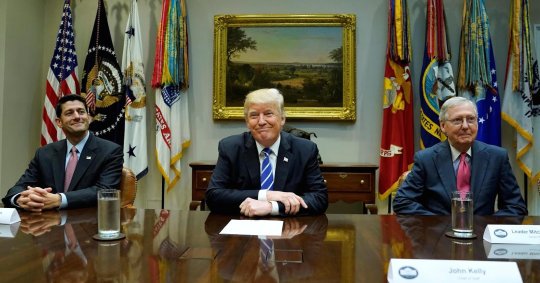
Social Security is unquestionably the nation’s most important social program, with more than three out of five current retired workers leaning on it to account for at least half of their monthly income. Yet, this crucial program is on shaky ground, with the latest annual report from the Social Security Board of Trustees painting a grim intermediate- and long-term picture for the program.
According to the report, Social Security is facing an inflection point this year. For the first time since 1982, aggregate expenditures, which almost entirely includes benefits, but also takes into account administrative expenses and Railroad Retirement exchange contributions, will exceed revenue generated. Although the net cash outflow is only estimated at $1.7 billion, which is relative peanuts when compared to the $2.89 trillion currently in asset reserves, it’s a conclusive sign that the existing payout schedule isn’t sustainable.
Things begin to get really dicey in 2020 and beyond. Beginning at the turn of the decade, ongoing demographic shifts are expected to cause the net cash outflow to balloon. By 2034, following 16 years of outflows, the $2.89 trillion in excess cash is expected to be completely gone. Should this happen, Social Security would survive, but payouts to then-current and future retirees could be cut by up to 21%. That’s not a pleasant forecast given the noted reliance of seniors on the program.
Read Also: How Many Seats Did The Republicans Win In Senate
Yes Republicans Want Big Time Cuts In Social Security
Over the last couple weeks, Dylan Scott has been out front on the House GOPs effort manufacture a Social Security funding crisis that would hit over the next two years. Theres more than one Social Security Trust Fund. Theres one that covers most retirees. Theres another that covers the disability part of the program. And over the years, Congress with little controversy has shifted funds back and forth between the two to maintain actuarial balance. So to date, the whole push has been rather technical and framed around bean counting. But earlier this month, most notably from Rand Paul, we heard the other prong in the attack come into play.
Speaking to Republican presidential primary voters in New Hampshire, Paul said that most Social Security disability recipients are in fact malingerers and scofflaws who have no business receiving benefits in the first place.
The thing is that all of these programs, theres always somebody whos deserving, everybody in this room knows somebody whos gaming the system. I tell people that if you look like me and you hop out of your truck, you shouldnt be getting a disability check. Over half the people on disability are either anxious or their back hurts. Join the club. Who doesnt get up a little anxious for work every day and their back hurts? Everyone over 40 has a back pain.
The Republican Record On Social Security
1935: Almost all Republicans in Congress oppose the creation of Social Security.
1939: 75 percent of Republicans in Senate try to kill legislation providing Social Security benefits to dependents and survivors as well as retired workers.
1950: 79 percent of House and 89 percent of Senate Republicans vote against disability insurance to defeat it.
1956: 86 percent of Republicans in Senate oppose disability insurance; program approved nonetheless.
1964: Republican presidential candidate Barry Goldwater and future president Ronald Reagan both suggest that Social Security be made voluntary.
1965: 93 percent of Republicans in House and 62 percent in Senate vote to kill Medicare.
1977: 58 percent of Senate votes against amendment to provide semiannual increases.
1977: 88 percent of Republicans in House and 63 percent in Senate vote against an increase in Social Security payroll tax needed to keep the system solvent.
1981: President Reagan proposes $35 billion in Social Security cuts over the next 5 years. The cuts would have included the elimination of student benefits, lump-sum death benefits, and a retroactive elimination of the $122 minimum benefit for three million recipients.
1981: Reagan administration begins a wholesale review of the Social Security Disability rolls, resulting in over 560,000 eligibility investigations in 1982 360,000 more than the year before. Ultimately, at least 106,000 families were removed from the rolls.
Don’t Miss: How Many Republicans Won In Tuesday’s Election
The Average Retired Worker Could Be Taking Home A Lot Less From Social Security In 15 Years
This has been a challenging year in so many respects for the American public. The COVID-19 pandemic has completely changed the way we interact with one another, and it’s displaced more than 20 million workers. If you’re an investor, you were also taken on a wild ride, with the stock market packing about 10 years’ worth of volatility into a period of four months. And don’t even get me started about the murder hornets.
But one of the few solaces working Americans have always been able to take is the idea that, if they earn 40 lifetime work credits, a Social Security benefit will be waiting for them when they retire.
The Social Security program has navigated through 13 recessions prior to the COVID-19 pandemic. Despite some obviously grim outlooks during those previous recessions, you’ll note that Social Security is still here, and it’s been paying continuous retired-worker benefits for more than 80 years. This is why it’s often referred to as America’s most successful social program.
But just because it’s been a historically successful program doesn’t mean it’s necessarily in great shape to service future generations of retirees.
Vote Tallies For Passage Of Medicare In 1965
GOP Rep: Let’s Privatize Social Security And Cut Benefits
Actions in Congress- H.R. 6675, The Social Security Admendments of 1965, began life in the House Ways & Means Committee where it passed the Committee on March 23, 1965 and a Final Report was sent to the House on March 29, 1965. The House took up consideration of the bill on April 7th, and passed the bill the next day by a vote of 313-115 . The Senate Finance Committee reported the bill out on June 30th and debate began on the Senate floor that same day, concluding with passage on July 9, 1965 by a vote of 68-21 . The Conference Committee to reconcile the differing bills of the two houses completed its work on July 26th. The reconciled version of H.R. 6675 then went to final passage in the House on July 27th and final passage in the Senate the following day.
You May Like: What Republicans Voted To Impeach The President
The Republican Obsession With Dismantling Social Security And Medicare
The Republicans are desperate to destroy Social Security and Medicare. These two programs demonstrate government at its best. The federal government runs these two extremely popular programs more efficiently, universally, securely, and effectively than the private sector does with its alternatives or indeed could, no matter how well those private sector programs were designed.
Because Social Security and Medicare are government programs that work so well, the Republican elite with its seemingly religious belief that the private sector is always the best hates them. So obsessed are the Republicans in their desire to eliminate these effective government programs that the very first action that House Republicans took in the new Congress was to adopt a rules package that included a new rule that amounts to a stealth attack on Social Security and Medicare.
The rules package, adopted at the start of every new Congress, sets out how the chamber will operate for the next two years. This years package is already infamous for provisions in the initial version that would have gutted the Office of Congressional Ethics provisions that were ultimately dropped after a massive outcry from the American people. Unnoticed by most was an additional provision, which is one part of the Republican game plan to destroy Social Security and Medicare.
Here’s How The Gop Could Remove $174 A Month From Retirees’ Paychecks Without A Direct Cut
On Capitol Hill, both political parties have acknowledged that Social Security needs some TLC. Unfortunately, neither party is in the same ballpark as to how best to fix what’s estimated to be a $13.9 trillion shortfall over the next 75 years.
What isn’t in doubt, though, is that if Republicans were able to implement their two most prominent solutions, every beneficiary would see some form of reduction in their payout.
The GOP has long favored cost-cutting as the best means of reducing Social Security’s shortfall. The most commonly touted method of tackling this would be by gradually raising the full retirement age — i.e., the age at which you become eligible for 100% of your monthly payout. Currently set to peak at age 67 in 2022 for those born in 1960 or later, Republicans would like to see this figure gradually increased to age 70. Such a move would require future generations of retirees to either wait longer to collect their full payout or to accept a steeper up-front reduction by claiming early. No matter their choice, lifetime benefits, and therefore program outlays, would be reduced.
But the thing about raising the full retirement age is that it takes a long time to work. Meanwhile, the other Republican proposal — changing Social Security’s inflationary tether from the Consumer Price Index for Urban Wage Earners and Clerical Workers to the Chained CPI — could yield modestly faster savings.
Read Also: What If The Republicans Win Everything Again
Softening Social Security Rhetoric On The Right
This represents a break from Angle’s past comments. Her website used to say that Social Security should be “transitioned out” in favor of “free market alternatives.
But that has been replaced with a markedly different stance.
“We must keep the promise of Social Security by redeeming the ‘IOU’s’ that have been written to the Social Security Trust Fund and then putting that money in a lock box that cannot ever be raided again by Washington politicians. The only way we pay for it is by cutting spending,” it now says in the “issues” section.
Talk of a “free market” alternative is replaced with “personalized accounts for the next generation that cannot be raided.”
Still, that careful rebranding will be complicated by comments she made Friday, when she apparently referred to Chile as a model for privatizing social security in the future, according to a short AP write-up.
Democrats Hope To Turn Attention From Economy
For their part, Democrats are intent on convincing voters that Republicans want to privatize the whole system.
“Republicans are dead set on privatizing or eliminating Social Security to please their Wall Street backers,” said Democratic Senatorial Campaign Committee National Press Secretary Deirdre Murphy.” Democrats will continue to stand up for our seniors and call out Republicans who want to leave them high and dry.”
But he said changing the subject from the economy will be challenging.
Progressive Groups Seek A “No Cuts” Pledge
Heals Act Vs Heroes Act


In a joint statement issued Tuesday afternoon, Pelosi and Schumer outlined where they said the HEALS Act falls short compared to Democrats Health and Economic Recovery Omnibus Emergency Solutions Act, which passed the House in May.
The $3 trillion Heroes Act extends $600 weekly unemployment benefits through January;2021, whereas the HEALS Act;cuts supplemental unemployment benefits to $200 a week through September, when the payment will be combined with state benefits to replace 70% of wages.
Pelosi and Schumer also said HEALS gives wealthy corporations a business meal tax deduction but doesnt extend the Supplemental Nutrition Assistance Program for struggling families. The Heroes Act provided;a 15% increase to the maximum SNAP benefit and additional funding for nutrition programs.
The Heroes Act contains $175 billion in new supports for rent, mortgage and utility payments and other housing-related costs.
HEALS, Pelosi and Schumer said, also provides zero election funding or Post Office assistance, while spending $2 billion on President Trumps priority to renovate the FBI headquarters and prevent competition for Trump Hotel and handing a $30 billion slush fund to defense contractors.
HEALS does not extend the eviction moratorium, provide rental or mortgage assistance or boost state and local funding, Pelosi and Schumer added.
Related on ThinkAdvisor:
Recommended Reading: When Did The Southern Democrats Become Republicans
0 notes
Text
*Aristotle: Ethos and Logos and Pathos*

In this entry, I will examine the critical question(s):“What is the main purpose of this artifact's message and how are ethos, pathos, and logos used in this rhetorical artifact to achieve that purpose? Is the way that these rhetorical appeals are used ethical?”
To investigate these questions, I examined Ronald Reagan’s 40th Anniversary of D-Day speech. Ronald Reagan used ethos, logos, and pathos to argue that D-Day heroes should still be remembered and honored, which is overall ethical because, as a society, we should continue to value our veterans and fallen troops since they sacrificed their lives for us.
D-Day, June 6, 1944, was when Operation Overlord took place. This was part of the Battle of Normandy in France during World War II. The operation, originally planned for June 5, had to be delayed due to bad weather (History.com Editors). Dwight D. Eisenhower ordered the invasion, which was the largest invasion force in history. D-Day has been regarded as the greatest military achievement due to its stake for the future and strategy (Wenzl, 2019). The Allies persisted through marshes and hedgerows and claimed victory at the end of August 1944 when Europe was liberated. Forty years after D-Day, June 6, 1984, President Ronald Reagan gave a speech to the world leaders and veterans to commemorate the veterans and lives lost during the Battle of Normandy. The speech took place at the site of the U.S. Ranger Monument at Pointe du Hoc, the same place where the battle took place 40 years prior (History.com Editors).
Aristotle, a Greek philosopher, studied and taught rhetoric, which he believed was an art. He identified three technical or artistic proofs as a way to answer what a rhetorician studies and what it teaches. The three proofs were logos, pathos, and ethos, which all accomplished different things in a speech. Logos refers to the study of reasoning and logical arguments, which have to be explicitly told or inferred in order for the audience to understand. Aristotle defined pathos as using emotional appeals to put the audience in the right frame of mind to persuade them to take action. Ethos is when a speaker shows their personal credibility and character through the speech. The character can be broken down into three parts: “phronesis (intelligence, good sense), arete (virtue), and eunoia (goodwill).” (Herrick, 2013). This element should not be overlooked when the speaker knows his audience. These proofs can be used in any of the three types of speeches: deliberative, epideictic, and forensic (Herrick, 2013). Ronald Reagan’s speech is known as an epideictic speech because he is celebrating the veterans for their courage on D-Day.
Reagan uses an ethos appeal by referring to faith and God throughout his speech. A quote that inspired the audience to listen to him was “What inspired all the men of the armies that met here? We look at you, and somehow we know the answer. It was faith and belief.” (“Ronald Reagan”). Faith is part of most people’s lives in one way or another. We all may trust in different things, but the majority of us believe in a higher power that gives us hope and faith. Reagan references faith and God multiple times throughout his speech to get the audience of veterans and leaders to believe and trust in him. Reagan did not want to over-shine the veterans by stating he is the president and therefore has the authority to give this speech. Instead, he references God to show his selflessness. He says “We're bound today by what bound us 40 years ago, the same loyalties, traditions, and beliefs.” (“Ronald Reagan”). The traditions and beliefs that united the soldiers were made possible by God. Reagan does not give himself credit that he is the reason the veterans are bound and strong. He did not say that the former president or an event caused them to risk everything to defend the country, but faith. It is smart to use faith and God because it is rather hard to disagree that God was not a part of any of the success and most people generally accept that. Near the end of the speech, Reagan vows to remember the dead and shows that by reciting this Bible verse; “I will not fail thee nor forsake thee.” (“Ronald Reagan”). The world leaders and veterans were more inclined to listen and accept the vow because the verse resonated with them and reminded them of the promise God made. It is ethical and moral to do as God promised and remember and honor the veterans.
Reagan uses a logos appeal, primarily facts, to remind the audience that what the troops did 40 years ago is still honorable and relevant today, which encourages them to still remember and honor the veterans. The facts he includes are “The air is soft, but forty years ago at this moment, the air was dense with smoke and the cries of men, and the air was filled with the crack of rifle fire and the roar of cannon.” and “Two hundred and twentyfive came here. After two days of fighting, only ninety could still bear arms.” (“Ronald Reagan”). One way to encourage people to remember an event or person is to list facts of what happened and the qualities that person possessed. Throughout the speech, Reagan states facts about D-Day that show why the events and veterans should be remembered. He opens the speech with a visual of what the U.S. Ranger Monument at Pointe du Hoc would look like. Reagan wanted the audience to picture what the atmosphere was like and realize this was no ordinary day, but one that was filled with violence, loss, and victory. Less than half of the soldiers came out of the battle alive, which shows how there are many lives to be remembered. The word choice in “Their mission was one of the most difficult and daring of the invasion” also reveals how D-Day should still be remembered (“Ronald Reagan”). He wants the audience to know that Operation Overlord was not just any mission, but the most difficult and daring and he used superlatives to achieve that. The harsh reality of D-Day will help the veterans remember and honor the soldiers. Reagan’s memorable last line in his speech, “let us continue to stand for the ideals for which they lived and died.” left the audience encouraged to remember the veterans who died and to honor them by standing for ideals, such as democracy (“Ronald Reagan”). Since the soldiers died standing for the ideals, it is logical for the audience to defend them and continue to honor the fallen soldiers. Reagan stated the facts he did to remind the audience that what was done 40 years ago is still honorable and the greatest military achievement should not be forgotten.
Reagan chose to present his speech at a specific location, which uses a logos appeal and motivates the audience to remember the heroes of D-Day. After the speech, Reagan “unveiled memorial plaques to the 2nd and 5th U.S. Army Ranger Battalions.” (“Ronald Reagan”). Memorials are given to those who made an impact on our country and sacrificed their lives for us. He chose to reveal the memorial to encourage people to remember the heroes of D-Day. One purpose of memorials is for people long after the event to remember what people did before us that made America how it is today. Also, the physical location of the speech, on the northern coast of France, is where the battle began 40 years ago. Immediately, before Reagan started speaking, the veterans could have logically remembered all of their brothers they lost based on the physical location of the speech.
Reagan uses a pathos appeal to encourage the veterans to be prideful of what they accomplished and remember their brothers who fought beside them. He states what they should be prideful for when saying “All of you loved liberty. All of you were willing to fight tyranny, and you knew the people of your countries were behind you.” (“Ronald Reagan”). Reagan wants the veterans to be proud of themselves because they sacrificed their lives and fought for what they believed was right and just. Several times throughout his speech Reagan highlights things that the veterans did, such as free a continent, fight against tyranny, and fought for life. These are all huge accomplishments that some veterans might be humble about and dismiss off as being a team effort or believe “I did what had to be done.” Although both those things are true, Reagan pointed out what was accomplished to remind the veterans that what they did 40 years ago still matters and impacts today's world. He refers to the veterans as champions while saying “These are the champions who helped free a continent.” (“Ronald Reagan”). That word refers to someone who is brave, dedicated, and fought for a cause. The veterans should feel proud after hearing the President say they are champions. Reagan shows respect and pride as he says “Gentlemen, I look at you and I think of the words of Stephen Spender's poem. You are men who in your "lives fought for life and left the vivid air signed with your honor.”” (“Ronald Reagan”). His choice of the word ‘gentlemen’ has an impact on the veterans. It implies that he is proud of them, respects them, and recognizes that they have grown since they fought at Normandy. It has a different connotation than ‘men’ and ‘boys,’ which were the words he used to address them previously in the speech. The rhetorical question “What impelled you to put aside the instinct for self preservation and risk your lives to take these cliffs?” shows the momentous decision that the veterans made. He acknowledged that the veterans made the life-changing decision to put themselves in harm's way for their country. Asking a rhetorical question is more powerful than stating a fact because it makes the audience pause and think about the sacrifice the veterans made. Reagan is proud of the veterans for making an unfathomable decision to risk everything.
Reagan instills determination into the audience when using a pathos appeal to get the audience to remember and honor the veterans. He briefly describes what the veterans endured in “the American Rangers began to climb. They shot rope ladders over the face of these cliffs and began to pull themselves up. When one Ranger fell, another would take his place. When one rope was cut, a Ranger would grab another and begin his climb again. They climbed, shot back, and held their footing.” (“Ronald Reagan”). One honorable characteristic in people, and especially in soldiers, is determination. Reagan believes that this is an important quality to display so he shows the veteran’s determination while fighting in Normandy. He wanted to remind them that their dedication and persistence led to the victory in Normandy and that the same mentality must continue in order to keep America safe. The soldiers did not doubt the reason they were fighting or kept fighting because they knew what had to be done in order to liberate Europe. Not only were the soldiers determined during the war, but also after. There were lives and nations that had been destroyed and had to be reborn. The Allies found strength in their faith, loyalty, and love and “rebuilt a new Europe together.” (“Ronald Reagan”). There was still sadness and unwanted Soviet troops after the war and during the time of this speech which meant the allied forces still had to protect and defend democracy. There was not a moment when the soldiers were not fighting for our freedom which shows a tremendous amount of determination. Reagan wants the determination to continue in order to keep America safe so he reminds the veterans of what they had accomplished 40 years ago. This also helps the audience remember and honor the veterans of D-Day because determination is a memorable characteristic.
Ronald Reagan used good, ethical, and appropriate appeals that the immediate audience and people long from then would accept and not criticize. He referred to God multiple times which was appropriate because many believe in faith and do not question what God said or did. Facts was a conservative way to appeal to logos because people can not argue and dispute facts. Since this was an epideictic speech, Reagan wanted the audience of the veterans and world leaders to feel pride and determination, non-controversial feelings that usually boost a person’s mood. The majority of the speech was praising the veterans and urging the audience to remember all the heroes of D-Day. While this is good and fitting for the type of speech, it poses a few limitations. Reagan does not mention anything specific that could have been improved and only gave glances at what the veterans endured through the Battle of Normandy. One reason for this is because part of the audience was veterans who probably did not want to relive that day. He did not criticize the mission or speak about the U.S. policies because that could have been seen as disrespecting the veterans and world leaders. This does not make the speech unethical because Reagan was giving an epideictic speech, which should praise and celebrate people. Although he did not address specific issues, he admitted “not all that followed the end of the war was happy or planned.” (“Ronald Reagan”). The soldiers' successes and best efforts were enough to liberate Europe but caused some harmful effects after the war. Reagan briefly stated that America learned from the past two world wars to be prepared to defend the country at all times, but does not want to enter another war. He states that he would welcome reconciling with the Soviet Union since it would lessen the risks of war. However, he did not address what effects that this may bring. Throughout the speech he does not address any U.S. policies or his opinion on war, rather he uses the speech to celebrate, honor, and remember the veterans which is ethical for the specific occasion of the 40th Anniversary of D-Day.
Ronald Reagan’s 40th Anniversary of D-Day speech used ethos, logos, and pathos appeals to encourage the audience to remember and honor the veterans who served in the Battle of Normandy. This is ethical because society believes it is important to remember and honor veterans and instills that in young children. Reagan referenced faith and God as an ethos appeal to defer the attention from him since this speech was meant to speak highly on the veterans. Facts was a logical way to get the audience of world leaders and veterans to remember all the violence, loss, persistence, and victory in Normandy. The rhetorical proof that was arguably used the most in this speech was pathos, appealing to someone’s emotions. Reagan wanted the veterans to be proud of themselves for their victory in Normandy and to feel determined to continue fighting to defend the country. This speech was ethical and productive despite the minimal discussion of policies and further decisions to enter war because it was an epideictic speech that served the purpose to remember and honor the veterans of D-Day.
References
Herrick, J. J., (2013). The history and theory of rhetoric: An introduction. Hope College.
History.com Editors. “D-Day.” A & E Television Networks, 5 June 2019, https://www.history.com/topics/world-war-ii/d-day. Accessed 14 March 2021.
“Ronald Reagan On the 40th Anniversary of D-Day.” The History Place: Great Speeches Collection, https://www.historyplace.com/speeches/reagan-d-day.htm#:~:text=We're%20here%20to%20mark,reclaim%20this%20continent%20to%20liberty.&text=Here%20the%20Allies%20stood%20and,the%20northern%20shore%20of%20France. Accessed 14 March 2021.
Wenzl, R. “How D-Day Changed the Course of WWII.” A & E Television Networks, 5 June 2019, https://www.history.com/news/d-day-important-world-war-ii-victory. Accessed 15 March 2021.
0 notes
Text
Corporate media: The free press isn’t free enough
This essay covers several reasons behind corporate media’s failure to cover news in a way that benefits the people. The following is the bulk of an essay I wrote years ago. It was published widely on the Internet then, and most of it can easily apply to today’s corporate news media.
In this essay, I mentioned we need real independent media, and today we have that via online journalists. Corporate owned media is still as unreliable as it was when I wrote this, but luckily many Internet media sources are reliable.
We have a free mainstream press in this country. It’s just not free enough.Thomas Jefferson said we can preserve democracy only with a fully informed electorate. If the media had fully informed voters about the antidemocratic nature of Iran-contra, would people have lobbied political leaders to alter its course? If the media had informed the public about the savings and loan scandal in a timely way, would taxpayers be burdened with the economic repercussions?
Here’s a test to determine whether the media have done a good job conveying all the news most Americans need to know about any given important news story:(1) Is that story fully understood by most Americans? Is it common knowledge? (2) Do most Americans understand the news story’s meaning and significance—in depth and detail? Do they see how the story relates to their daily lives?
How many ordinary Americans do you personally know who fully understand the savings and loan scandal? How many do you know who understand Iran-contra in depth including its meaning and significance? . . .
. . . Everybody expects certain politicians to flack for corporate contributors, but the public expects mainstream news reporters to be democracy’s watchdogs . . . Mainstream news organizations perpetuate the civic-minded-journalist myth. When challenged, mainstream journalists are often defensive and admit no wrongdoing. The rare times mainstream news folk self-criticize they still don’t get to the heart of the matter. For example, a recent study by the American Society of Newspaper Editors (ASNE) shows readers are concerned about newspapers’ spelling or grammatical mistakes and about factual errors, accuracy, bias, spin, and special breaks for powerful people or organizations. Edward Seaton, president of ASNE, says he wants to “rein in the pundits” and reconnect with readers.
How can news organizations connect with readers when corporate moguls who own the media often stand between reporters and readers? In a July, 1986, Cosmopolitan interview, media mogul Rupert Murdoch was asked to what extent he controls his newspapers’ editorial position. Murdoch, who described himself as a “radical conservative” said: “Considerably. The buck stops on my desk. My editors have input, but I make final decisions.” If Murdoch at times acts as a defensive back, blocking his subordinates’ efforts to pass to the public any version of the news that hurts his financial interests, we need a whole new kind of journalistic ball game.
Concentrated corporate ownership affects the quality of journalism. The people-friendly press has been replaced by corporate-friendly conglomerates. Family owned newspapers—papers that once took up for interests of average Americans—have virtually disappeared due to a declining marketplace. The corporate-friendly press puts profit ahead of public service. Corporate owners don’t spring for costly investigative reporters—especially not ones who make waves with business advertisers or very powerful public figures.
Here is the heart of the matter: “News” washed clean of the real corruption in society—in other words, news that omits misdeeds of those wealthy and powerful public figures with the most clout—is anemic disinformation. The public can’t connect with it because whitewashed news is nothing we can use. It doesn’t link with our daily lives.
Corporate-friendly (as opposed to people-friendly) media do more than limit ideas. They often advocate or emphasize only ideas that benefit corporate owners. Media moguls like Rupert Murdoch have an obvious economic stake in a certain political agenda: fewer taxes on the wealthy; fewer regulations of business and so forth. Media giant TCI’s John Malone speculated Murdoch would likely be glad to keep Fox News Channel on the air even if the network didn’t make a profit—for political leverage alone. If networks are used for political leverage by media owners whose economic interests clash with the interests of average taxpayers or labor groups, the public needs to seek alternative sources of information.
Media decision-makers often deny they are controlled by corporate media owners. But subordinates no doubt anticipate how far they can push the envelope and then censor themselves. Network news directors rarely pound away at stories that seriously jeopardize wealthy and powerful villains—at least not those with the most wealth and clout (meaning the ones who can do the most damage.)
Journalists are sometimes fired or harassed for challenging the rich and powerful. Media critic Michael Parenti (Inventing Reality: The Politics of News Media) offers a number of examples, among them: Reporter Bill Collins was fired from the Winston-Salem Journal for “union activity and writing too much about labor.” An NBC reporter, Jon Alpert, was fired by NBC’s Michael Gartner when Alpert brought back Gulf War footage showing damage done to civilian areas by U.S. aerial attacks. New York Times columnist Sydney Schanberg’s column was canceled by publisher Sulzberger when Schanberg wrote too much about the greed of New York’s bankers and other moneyed interests.
Corruption involving society’s wealthiest and most powerful miscreants is the very kind of corruption that most affects our daily lives and is the kind that most needs to be corrected if the country is to improve. This is not a plea for scatter-gun scandal-mongering or random smear campaigns aimed at ruining wealthy public figures without just cause. However society’s most insidious corruption often originates among the wealthiest one-percent of Americans (whose total net worth is greater than the total net worth of the bottom ninety percent) and among the corporate media moguls who flack for them. If mainstream media won’t fully cover union grievances because it offends wealthy corporations, or won’t cover war-time abuses because it offends arms manufacturers, or ignore Wall Street’s greed because it offends bankers, then we need new sources of news media.
If news organizations want to convey news that matters, it’s not enough to offer occasional stories in piecemeal fashion on important issues. For the public to grasp the meaning and significance of news stories, the media must go beyond casually tossing out first one random piece of a puzzle and then another—sometimes publishing or airing one piece of the puzzle weeks after the first piece appears. When a meaningful, complete puzzle exists responsible media should present the whole picture to the public—all at once and often.
Some journalists claim it’s not their job to clarify meaning and significance for viewers or readers and that they have no obligation to put puzzles together in a truthful, public-advocating manner. However, media organizations do piece news stories together in ways that promote corporate interests . . .
Michael Parenti says the way news is framed is all-important. Framing involves “the way news is packaged, the amount of exposure, the placement (front page or back, lead story or last), the tone of presentation (sympathetic or slighting), the accompanying headlines and visual effects.” Propaganda is more effective when done with framing than with obvious coercion.
If the media cared more about public service than profit, what difference would it make to ordinary Americans? If we’d had truth telling mainstream media when the savings and loan crisis started or during Iran-contra, might ordinary people have banded together to help avert those blunders? Rep. Henry B. Gonzalez (D-TX) testified as early as 1982 before the House Rules Committee, warning of the pending S&L disaster. Gonzalez , who is now retired, is a rare breed of politician who worked on behalf of the public and not exclusively for corporate “clients.” Although his speeches appeared in the Congressional Record, and while thousands of political reporters knew of the coming S&L disaster, virtually no reporters covered the story. Gonzalez called a press conference in the spring of 1988 in a near panic about the coming crisis. The only press people who showed up were a few from the financial industry trade papers and some Texas reporters. (Bill Greider, Who Will Tell The People.)
The mainstream media never explained the S&L scandal to the public so that its details became common knowledge, nor did the media clarify Iran-contra. Tim Weiner writes in Blank Check, the book based on his Pulitzer Prize winning newspaper series on the Pentagon’s black budget: “No one ever stood trial for the true crimes of the Iran-contra conspiracy. No one ever will. The White House, the Justice Department and the CIA made sure of that.” Attorney General Richard Thornburgh and certain national security officials declared important facts regarding the case to be sensitive secrets. Those secrets—including key defining details—were sealed, allowing prominent Iran-contra figures to escape scrutiny and prosecution. Independent prosecutor Lawrence Walsh said the sealed material amounted to “fictional secrets.”
Nothing has been done to discourage another Iran-contra. Ronald Reagan and Oliver North escaped serious media scrutiny, and Congress hasn’t enacted a single preventive measure. Why didn’t the media (on the whole) do a better job reporting the S&L scandal and Iran-contra? Many reporters who knew about the savings and loan story were focused on relatively trivial matters, for example on lighter aspects of the 1988 presidential campaign.
Some news organizations caved to pressure to give only the military-intelligence version of Iran-contra according to former Newsweek reporter Robert Parry (Fooling America) However a key underlying reason those and other important news stories are neglected or covered in misleading ways is that, in general, mainstream media primarily serve interests of the wealthy and powerful—often at the expense of the rest of us.
Many politicians listen only to their wealthy corporate contributors and disregard the views of the rest of the electorate. Considering politicians’ indifference to public opinion, would it have mattered if the news media had reported the savings and loan scandal and Iran-contra in a way that made the details fully understood by most Americans? Yes, it likely would have made a difference. If the general public had known the implications of the pending S&L crisis or the reasons Iran-contra figures escaped scrutiny, people might have chosen to respond. At least, armed with information, the public would have stood a fighting chance to act on our own behalf.
If the news media had fully informed the public, more people might have bothered to vote in order to eliminate (vote against) politicians who participated in the S&L scandal and Iran-contra. People might have formed legitimate grassroots groups or joined existing organizations to work toward preventing similar events in the future. Public figures often complain that few Americans vote or participate in politics. More people would be inspired to vote and participate in public affairs if the mainstream media conveyed news fully and clearly, showing the public what is at stake. An informed electorate is an empowered electorate.
Robert W. McChesney, Associate Professor of Journalism at the University of Wisconsin, says that when Ben Bagdikian’s The Media Monopoly was first published in 1983, all U. S. mass media were controlled by around fifty corporations. Today approximately ten firms dominate all mass media. Various media owners are involved in joint ventures with their “competitors.”
Those joint ventures reduce real competition and create monopolistic tendencies. A virtual media monopoly obviously curbs the range and scope of ideas flowing from mainstream media to the American people. Yes, a few news organizations offer an occasional “people-friendly” expose of corporate misdeeds, and there are good journalists who tell the truth and do an excellent job. The public could seek them out.
Here’s the problem: When people believe we already have reliable mainstream media, they don’t seek supplemental news. Many Americans believe the myth of the noble tribune and think if a news story were important it would be mentioned often on network TV or reported daily on the front pages of their newspapers and in every issue of prominent news magazines. Most Americans don’t work to unearth key news stories (in other words, do their own investigative journalism) because they buy the myth that caring journalists will do that for them. Some people believe in the idea that all journalists are noble watchdogs the way they once believed in Santa. Americans must shake off the illusion that the mainstream media serve “the people.”
Ordinary Americans need truth telling, public-advocating mainstream media organizations with their finger on our pulse and corporate America’s chains off their backs. We are not likely to get them. We’ll have better luck strengthening the country’s alternative media—those publications not entirely controlled by corporate money and profit motive. A public sponsored all-news television network might be a good start (a sort of all-news PBS that thrives only on private and not corporate contributions.) Those people who trust the mainstream media won’t bother to seek news elsewhere. What the public needs most is to enlist educators and others to spread the word through society that the mainstream media can’t be trusted to provide all the news Americans need if we want to be well informed enough to keep democracy.
Michael Parenti quotes journalist John Swinton who attended a newspaper editors’ banquet in the early years of the twentieth century. Swinton responded to a toast to the free press this way: “There is no such thing in America as an independent press . . . You know it and I know it. There is not one of you who dares write his honest opinions, and if you did, you know beforehand that it would never appear in print . . . We are the tools and vassals of rich men behind the scenes. We are the jumping-jacks; they pull the strings and we dance. Our talents, our possibilities, and our lives are all the property of other men. We are intellectual prostitutes.” Swinton’s assessment is still accurate today when applied to corporate media.
It’s time the American people banish the myth that we have a free (enough) mainstream press and see most mainstream corporate media organizations for what they are. Unlike the proverbial Emperor, these media posers do wear clothes—short skirts, six-inch heels—but they wear no shame at all.
7 notes
·
View notes